Diving & ROV specialists



Scientific publications

Videos and animations

Procedures, historical diving,
and other technical documents
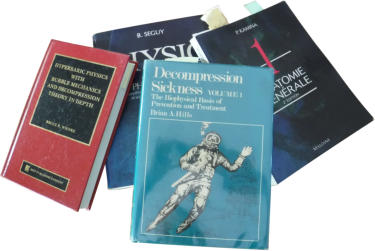
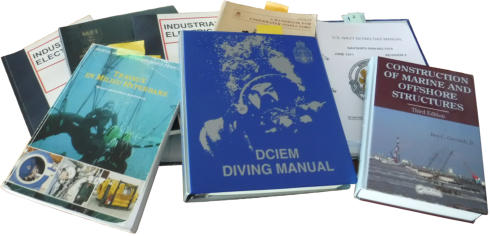

Equipment to take into consideration


Help us to make this website better
This website is the result of the combined efforts of scientists,
document writers, engineers, divers, and client representatives. It
stands as an independent platform committed to providing accurate
and honest information, free of any external influences from pressure
groups. However, maintaining this level of quality requires a significant
time investment. As such, any support towards improving this project
would be greatly appreciated.
The following hyperlink permits contributions to be made via
"Librapay.com", a platform for donation crowd-funding.
As our principal office is in Thailand, the currency of reference for
donations is the Thai Baht. It should be noted that 1 USD equals
approximately 36-40 THB. .

Click on the
octopus to return to
the top of the page

Food for thought

Cultural activities

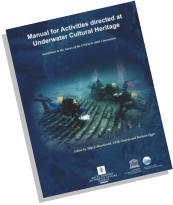
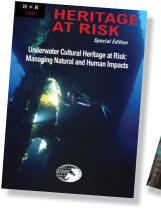
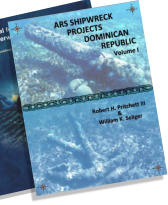
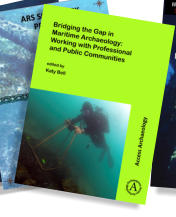


You can also help us by contributing articles or information.
You do not need to be a recognized scientist or engineer (although their
contributions are always welcome) and provide papers of the level of
those in the "Documents" section: Small, well-balanced posts in which
you tell us your thoughts on particular topics can be accepted and
published in the "Food for Thought" section, provided they are based on
proven facts and in accordance with our terms of use, displayed in the
"About Us" section (see in the navigation bar).
If you do not feel like a writer but have a recognized technical level, you
can join the team as an advisor and helper.
Best regards.
Christian Cadieux - Website manager.
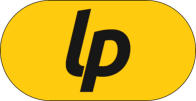
Moreover, it is possible to initiate transfers to a designated account via
SWIFT (with code SICOTHBK) or through traditional bank transfers.
For further information on the bank account particulars, kindly refer to
the "About us" section.




The purpose of this section is to provide small articles describing new
equipment that may be useful in organizing underwater operations. Its
other function is to highlight dangerous equipment, such as counterfeit
or poorly designed or manufactured systems, which may expose
users to hazardous conditions.
Please note that our previous articles remain in our database and can
be consulted at any time. Click on the button below to access them.

News
Also, recent announcements from various professional and safety
organizations, and lists of scientific and technical paid documents can
be consulted on a specific page by clicking the button below.

Please note that the hyperlinks to the guidelines and information
notes indexed in this section are provided for informational purposes
only. "Diving and ROV Specialists.com" assumes no responsibility for
the creation of any of these documents.
As stated in our "About Us" section, we operate independently and
have no plans to seek organizational membership. Our mission is to
furnish diving and ROV teams with reliable information written by us
or others, including materials published by professional organizations
that we consider integral to our responsibilities.
Nevertheless, as elucidated in Diving Management Studies CCO Ltd
#7 and #11's conclusion, every guideline put forth by an
organization must be scrutinized by qualified individuals who
determine its feasibility for their respective companies' utilization.
In other words, it is your prerogative to deem each document on this
page suitable or unsuitable for all aspects of your diving and ROV
operations.

The "Food for Thought" section disseminates concise articles on
various topics, providing readers with thought-provoking material that
facilitates the analysis of potential new markets and events that may
affect our respective professions now or in the future.
By adopting a non-monocultural approach to the development of our
professions, we can broaden our horizons and remain adaptable to
changing circumstances.
Please note that previous publications in this section remain in our
database and can be consulted at any time.
Click the button provided below to access the list and choose your
preferred article.



Studies of ROV and AUV Concepts
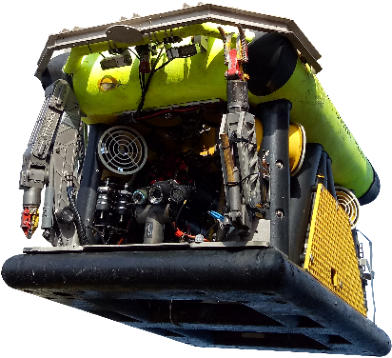

For those who prefer the convenience of sending money with just a
few clicks, “Skrill Money Transfer” is an international money transfer
service that offers more favorable rates than traditional banks.
To utilize this service, you must first register for a Skrill account by
downloading the app from Google Play or the App Store or visiting their
website at "https://skrill.com/en" and clicking the button "register."
Once registered, you can log in to your account and send money to
anyone registered on Skrill or make an international money transfer
by following step-by-step instructions.
As mentioned above, our bank account details are indicated in the
"About Us” section, which can be accessed via the navigation bar.
If the recipient's bank information is unavailable, funds can be sent
using their email address (for us, use: "management@diving-rov-
specialists.com"`). The transferred amount typically becomes
immediately available once it is completed.
More information is available by clicking the logo below.



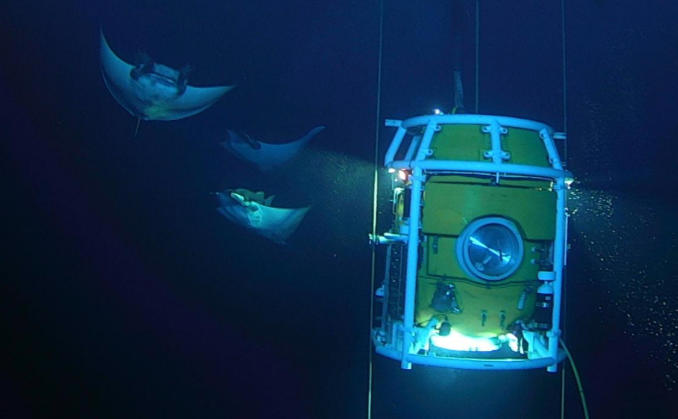
Courtesy of Fabrice Pipault

Note the documents “BMP Maritime Security” and “Maritime Industry
Security Treat Overview (MISTO)” below, which have been edited with
the support of most of the organizations listed in this section. Applying
the recommendations from these documents will:
•
Assist in planning voyages and offshore activities.
•
Improve understanding of marine threats and their impacts.
•
Reduce the likelihood of involvement in a maritime security incident.
•
Help determine mitigations to keep the crew and ship safe.
•
Provide reference information sources.
•
Specify contacts and reporting procedures for emergencies and
welfare assistance.
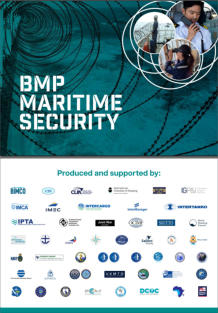
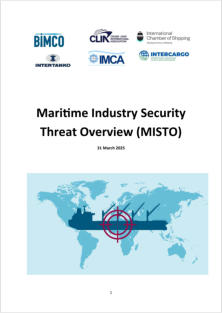
Our database has been enriched with an additional 93 papers
covering various topics, such as:
•
Diving and ROV procedures.
•
Historical diving
•
First aid
•
International conventions and national laws.
•
Technical documents regarding vessels and diving systems
•
Non-destructive inspection techniques
•
Underwater mapping
•
Underwater construction techniques
Kindly click on the provided link below to access the full list.

The Diving Management Study CCO Ltd. #13,
“Gap analysis between NORMAM-15/DPC-
2011 and NORMAM-222/DPC saturation
diving procedures”, compares the original
COMEX-based 2011 saturation procedures
with the new NORMAM-222/DPC procedures
published in 2023 to determine whether the
new guidelines align with the original
decompression model and, if changes exist,
whether they are documented and consistent.
No new "Diving Management Study", CCO Ltd, or manual "Diving and
ROV Specialist" documents are published in this edition. Two new
documents are currently in progress, one of which is nearly ready for
publication. In the meantime, the study below has been recently
published and should be considered. For a fuller analysis, we also
recommend reading the “Food for Thought” article “National institutions
must lead by example regarding the publication of official documents”.
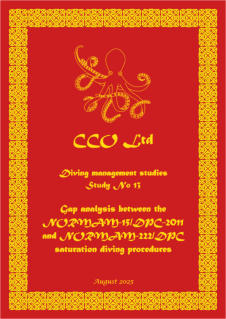

Publications CCO Ltd
and
Diving & ROV specialists
The documents categorized under the "Diving and ROV Specialists" and
"CCO Ltd" headings are in line with this website's mission to act
independently of external bodies by providing diving and ROV crews
with reliable information that we consider appropriate to the subject
matter. These resources are based on scientific and technical
documentation held within our database and nationally and globally
recognized standards and guidelines selected for their relevance.
Click on the button below the image to view the available documents
and their descriptions.
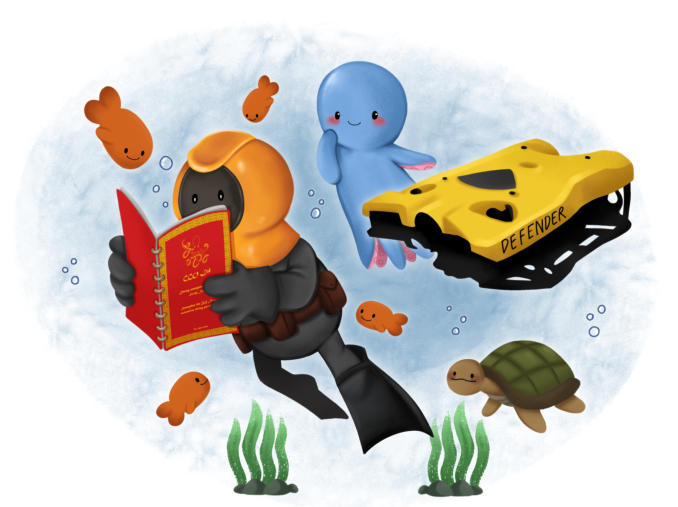

About this website
This website provides a comprehensive database for diving and ROV
operations, including scientific and technical documents, logistical
contacts, guidelines, and discussion topics, the latest of which are
summarized on this homepage.
Recognized by diving medical organizations such as SPUMS and EUBS,
which have granted us the privilege to redistribute their non-
embargoed publications, the site continues to expand with each edition
and attract growing numbers of visitors.
For details on our purpose and terms of use, please see the "About Us"
section in the top navigation bar. To access the site map, click on the
octopus icon below.
I sincerely thank everyone supporting this non-profit initiative and
welcome all those interested in joining us.
Christian Cadieux, Website Manager


Click on this octopus icon
to view the site map.
Edition of the 29th of December 2025
The document, "Calculating Cumulative
Pulmonary Oxygen Toxicity. Use of the Unit
Pulmonary Toxicity Dose (UPTD)", by H. Bardin
& C. J. Lambertsen, was the 1st article to
discuss this concept we had long sought.
While this system is gradually being replaced
by the new Surface Oxygen Time (ESOT), it is
still used in some publications and was an
essential part of the studies on oxygen toxicity
conducted to date.
"Physiological monitoring to prevent diving
disorders" is a study by Paul Beatty, William
Evans, Sara Gravelyn, and Marshall Tumperi,
emphasizing the importance of studying
human physiology for ensuring diver safety
during underwater operations. It details
various hazardous physiological phenomena
that divers can experience before, during,
and after dives, and discusses specific
physiological biomarkers that can be used to
evaluate a diver's physical condition.
We are actively expanding our database with new scientific documents.
While most of these papers address diving-related phenomena, many
also examine health issues associated with ROV operations and various
deck activities.
These documents form the essential evidence base for developing
guidelines and standards, and authors of such procedures should
consistently reference this foundational research.
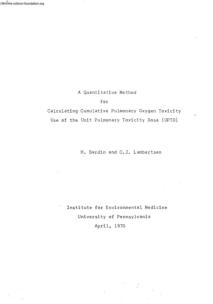
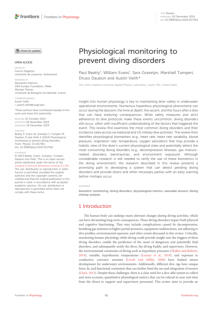
This section contains papers dealing with technologies applicable
to remotely operated and autonomous underwater vehicles. They
can be considered scientific studies dedicated to the above-
mentioned equipment.
29 documents have been added to our database, which contains
documents from the fifties to the present days.
Click on the button below to open the list of these new documents.
This article presents the development of
an underwater salvage robot designed to
locate and retrieve foreign objects in
nuclear reactor pools. The robot features
an ROV platform combined with a three-
degree-of-freedom Delta robotic arm and
utilizes advanced positioning and object
detection technologies.
Experimental tests demonstrated its high
effectiveness in identifying and retrieving
various foreign objects.
As indicated in previous editions, we continue expanding our
database with diverse documents, many of which discuss bio-
inspired underwater vehicles and advances in artificial
intelligence.
Among the new, high-quality papers featured in this edition, we
are pleased to highlight the study, "An Underwater Salvage Robot
for Retrieving Foreign Objects in Nuclear Reactor Pools," by Ming
Zhong, Zihan Gao, Zhengxiong Mao, Ruifei Lyu, and Yaxin Liu.
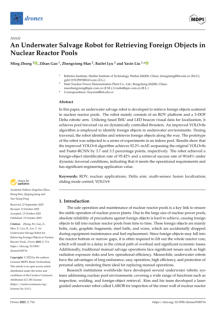
In addition to the documents mentioned above, environmental
concerns continue to grow. Therefore, 26 new papers on these
topics have been added to the database, whose list can be viewed
by clicking the button below.
As in previous editions, we continue to highlight the increasing reliance
on Remotely Operated Vehicles (ROVs) and Autonomous Underwater
Vehicles (AUVs) for non-destructive testing (NDT) inspections, mapping,
and numerous construction tasks. In addition, we focus on
underwater construction engineering, with emphasis on the strength
and life prediction of offshore and inland structures, including, but not
limited to, their foundations and protections.
“Deep Learning Approaches for Fault
Detection in Subsea Oil and Gas Pipelines:
A Focus on Leak Detection Using Visual
Data” is a study by Viviane F. da Silva,
Theodoro A. Netto, and Bessie A. Ribeiro
that focused on enhancing leak detection
methods in subsea oil and gas pipelines by
exploiting data from experiments that
simulated underwater leak conditions.
The study “Hydrodynamic Characteristic
Around the Riprap Protection of Monopile
Wind Power Foundation with Scour Pit During
Scour”, by Tongshun Yu, Li Wang, Congbao Mei,
and Xiaofeng Dong, investigates how riprap
protection affects hydrodynamics around
offshore wind power foundations during
scour events, highlighting phenomena that
may impact the foundation's stability.
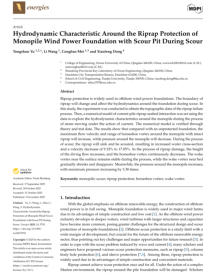
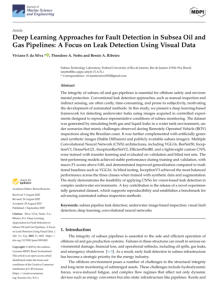
Our database contains diverse environmental documents, including
descriptions of fauna and flora and marine pollution studies from
multiple sources. While the oil and gas industry remains a focus
despite its environmental improvements, attention is also turning to
other sectors, particularly inland and underwater mining.
“The impact of H2S on Hg accumulation on
non-corroded pipelines and the
implications for assessing risks of
offshore decommissioning” is a study by
Liam Paton, Sandra Kiesel, & Jorg
Feldmann, highlights the need to address
contaminant concentrations, such as
mercury (Hg) and hydrogen sulfide (H2S),
during decommissioning operations.
The study "Multi-AUV sediment plume
estimation using Bayesian optimization" by von
See, Greinert, and Meurer addresses the
environmental impact of sediment plumes
from dredging and mining operations. The
authors propose a Bayesian Optimization-
based approach for coordinating autonomous
underwater vehicles (AUVs) as a sensor
network to monitor plume development.
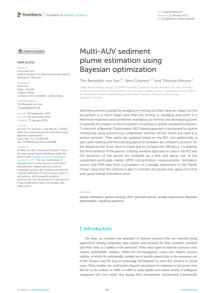
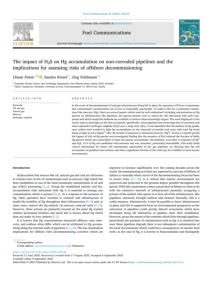
This section covers underwater archaeology documents, museums,
and activities that promote the history of diving and navigation.
Our database includes reports and studies by professional
archaeologists, UNESCO guidelines, and various national regulations
related to these activities, all of which should comply with the United
Nations Convention on the Law of the Sea (available in the "Documents"
section). There is also a list of museums and contact information for
those interested in starting diving but not yet committed to becoming
commercial divers.
While archaeologists have long relied on recreational divers, exploring
deep wreck sites inaccessible to them may require professional diving
teams and ROVs, following procedures used in the offshore industry.
Please note that 10 new documents have been added to our database.
Click the button below to view the list.
Videos and animations are available in the "Documents" section; they
are presentations on equipment, systems, and working practices
provided by manufacturers, workers, and various organizations, which
can be used to illustrate training courses, toolbox talks, and
conferences, or simply for individual learning.
It is worth noting that this database is regularly updated with
documents related to the articles published in the "Food for Thought"
and "Equipment to Consider" sections.
35 new animations have been added to the database. You can see the
list by clicking on the button below. You can also click on the images
above to open the pages where they are described and can be opened.
This article discusses photogrammetry as a scientific technique that
uses photographs or digital images to create accurate three-
dimensional representations of objects and environments.
It describes the origins of photogrammetry in the 19th century, with
contributions from pioneers such as Aimé Laussedat and Albrecht
Meydenbauer. The evolution of photogrammetry from manual
techniques to software-assisted processes is outlined, detailing its
application in underwater photography.
This article also emphasizes the technology’s benefits and provides
several lists of resources, allowing interested parties to make a
decision, based on documented facts, on whether to adopt it.
Implement Photogrammetry in Commercial
Diving & ROV Operations: A Resource Guide
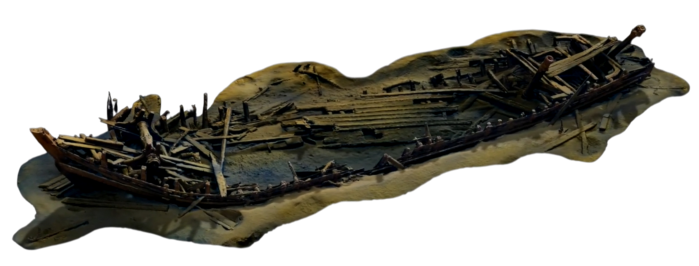
Logistics
•
Diving doctors & clinics
•
Medical equipment
•
Diving equipment manufacturers & suppliers
•
Underwater tools and their surface support equipment
•
ROV and AUV manufacturers
•
Underwater navigation and visualization systems
•
Logistic supporting services
•
Ship chartering companies
•
Shipyards
•
Training establishments & Recruitment agencies
•
Banks, insurances, and medical assistance
The Logistics section includes the following sub-sections, which
provide links to manufacturers and service providers. As with all our
other sections, we take pride in checking the hyperlinks every time we
update the site. However, it is important to note that websites can
malfunction for various reasons, even if they have worked seamlessly
during the overhaul.

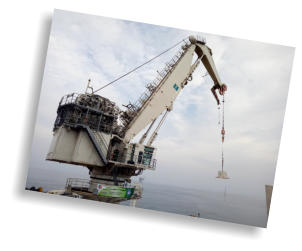
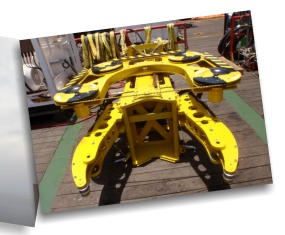



This article, authored by Dr. Jean Yves Massimelli of Nice
University Hospital (France), highlights the widespread
lack of medical preparedness, a critical issue in offshore
industries.
Drawing from a recent personal experience, closely linked to a friend's
cardiovascular emergency shortly after returning from work, Dr.
Massimelli underscores the urgent need for comprehensive medical
emergency response plans (MERPs). The piece emphasizes that
appropriate training, adequate resources, and swift response
mechanisms are vital to safeguarding offshore workers' health and
lives. Furthermore, it argues that neglect in this area, often driven by
cost-cutting measures, constitutes a significant safety risk.
By spotlighting the ethical and legal responsibilities of employers, the
article advocates for a paradigm shift in industry practices,
prioritizing medical readiness, strict adherence to safety standards,
and accountability, to better protect personnel and prevent preventable
tragedies during emergencies.
Click on the button below to open this post.

Because this site hosts a comprehensive document database, the
search engine above, featuring refined queries via the “Advanced
Search” button at the top of the box, along with “search tips”, is
available on this page and in the Documents section.
- Study No 1 - “Organize air & nitrox continuous diving operations”
- Study No 2 - “Organize the maintenance of diving cylinders”
- Study No 3 - “Implement a drug and alcohol abuse policy”
- Study No 4 - “Strengthen the US Navy saturation diving
procedures”
- Study No 5 “Implement NORMAM-15/DPC-2011 saturation
diving procedures (Today Normam222/DPC)”
- Study No 6 “A Novel Method for Estimating Diver Umbilical
Length in Dynamic Positioning (DP) Vessel
Operations”
- Document - “Description of a saturation diving system”
- Saturation diving handbook
- Book #1 - Definition and elements for preparation
- Book #2 - Gas supplies and chamber management
- Book #3 - Bell procedures
- Book #4 - Diving accidents
- Appendix
- Study No 7 - “History and evaluation of IMCA D 050 rev. 1.1 -
Minimum quantities of gas requiered offshore”
- Study No 8 - “Set a policy for electronic devices in chambers”
- Study No 9 - “Analysis of the document IOGP 411 rev. 2021 -
Recommended practices for diving operations”
- Study No 10 - “working at height during the mobilization and the
maintenance of diving and ROV systems”
- Study No 11 - “About pre-dive conditioning and commercial
diving”
- Study No 12 - “Aout standards”
- Basic rigging and lifting procedures handbook
- Surface-supplied handbook series
- Book #1 - Overview of surface-supplied diving operations and scope of his
series
- Book #2 - Description and prevention of accidents associated to diving
operations
- Book #3 - Legal aspects of project preparation
- Book #4 - Description and maintenance of surface supplied diving systems
- Book #5 - Managing weather, communications, surface supports &
underwater vehicles
- Book #6 - Prepare and manage the dives
- Book #7 - Implement the MT 92 tables
- Book #8 - Implement the DCIEM tables
Studies CCO Ltd
- Study No 13 - “Gap analysis between the NORMAM-15/DPC and
NORMAM-222/DPC saturation diving procedures”
Documents & handbooks “Diving and ROV Specialists”
Years 2015 to 2017
•
Effective depth of regular wave on submerged submarines and AUVs
Authors: Mohammad Moonesun, Firouz Ghasemzadeh, Yuri Korol, Nikrasov Valeri,
Alexi Yastreba, Alexander Ursalov
Year 2021
•
Review of Underwater Sensing Technologies and Applications
Authors: Kai Sun, Weicheng Cui, and Chi Chen
Year 2022 - part A
•
Research on the Effect of Needle Eccentricity on the Jet Flow Characteristics
Authors: Huang Jinwei1, Ge Xinfeng, Chu DongdongChu, Zhang Jing, Xu Bing,
Gao Fei, Zheng yuan
Year 2024 - Part A
•
Underwater Vehicle Path Planning Based on Bidirectional Path and Cached
Random Tree Star Algorithm
Author: Jinxiong Gao, Xu Geng, Yonghui Zhang, and Jingbo Wang
•
Pothole detection for autonomous vehicles using deep learning: a robust and
efficient solution
Authors: Malhar Khan, Muhammad Amir Raza, Ghulam Abbas, Salwa Othmen,
Amr Yousef, and Touqeer Ahmed Jumani

Year 2025 - Part B
•
An effective fault-tolerant control with slime mold algorithm for unmanned
underwater vehicle
Authors: Tianhong Zeng, Daqi Zhu, Chunhua Gu, Simon X. Yang
•
A systematic review of haptic texture reproduction technology
Authors: Si Chen, Tonghe Yuan, Lujin Xu, Weimin Ru, Dongqing Wang
•
Environment sensing technology of underwater ROV based on artificial siding
Authors: Wenhui Wang, Fumeng Ye, Rufei He
•
The use of emerging autonomous technologies for ocean monitoring: insights and
legal challenges
Authors: Aspasia Pastra, Tafsir Matin Johansson, Joana Soares, and Frank E. Muller-
Karger
•
Towards Autonomous Coordination of Two I-AUVs in Submarine Pipeline
Assembly
Authors: Salvador López-Barajas, Alejandro Solis, Raúl Marín-Prades, Pedro J. Sanz
•
Translation-based multimodal learning: a survey
Authors: Zhengyi Lu, Yunhong Liao, Jia Li
•
Powering Underwater Robotics Sensor Networks Through Ocean Energy
Harvesting and Wireless Power Transfer Methods: Systematic Review
Authors: Sverrir Jan Nordfjord, Saemundur E. Thorsteinsson, and Kristinn Andersen
•
Underwater Acoustic Integrated Sensing and Communication: A Spatio-Temporal
Freshness for Intelligent Resource Prioritization
Authors: Ananya Hazarika, and Mehdi Rahmati
•
Influence of Marine Environmental Factors on Characteristics of Composite
Magnetic Field of Underwater Vehicles
Author: Honglei Wang, Xinyu Dong, and Yixin Yang
•
Inductive Wireless Power Transfer for Autonomous Underwater Vehicles: A
Comprehensive Review of Technological Advances and Challenges
Authors: Han Xu, Rong Zheng, Bo Yang, and Wei Ning
•
Visual Signal Recognition with ResNet50V2 for Autonomous ROV Navigation in
Underwater Environments
Authors: Cristian H. Sánchez-Saquín, Alejandro Gómez-Hernández, Tomás Salgado-
Jiménez, Juan M. Barrera Fernández, Leonardo Barriga-Rodríguez, and
Alfonso Gómez-Espinosa
•
An Underwater Salvage Robot for Retrieving Foreign Objects in Nuclear Reactor
Pools
Authors: Ming Zhong, Zihan Gao, Zhengxiong Mao, Ruifei Lyu, and Yaxin Liu
•
Deep learning methods for 3D tracking of fish in challenging underwater
conditions for future perception in autonomous underwater vehicles
Authors: Martin Føre, Emilia May O’Brien, and Eleni Kelasidi
•
A Novel Cooperative Navigation Algorithm Based on Factor Graph and Lie Group
for AUVs
Authors: Jiapeng Liu, Xiaodong Bu, and Chao Wu
•
A CFD-Based Surrogate for Pump–Jet AUV Maneuvering
Authors: Younhee Kwon, Dong-Hwan Kim, Jeonghwa Seo, and Hyun Chung
•
Deep Learning-Assisted ES-EKF for Surface AUV Navigation with SINS/GPS/DVL
Integration
Authors: Yuanbo Yang, Bo Xu, Baodong Ye, and Feimo Li
•
Multi-AUV Cooperative Search for Moving Targets Based on Multi-Agent
Reinforcement Learning
Authors: Le Li, Ruiqi An, Zhaozhi Guo, and Jian Gao
•
Robust Underwater Docking Visual Guidance and Positioning Method Based on a
Cage-Type Dual-Layer Guiding Light Array
Authors: Ziyue Wang, Xingqun Zhou, Yi Yang, Zhiqiang Hu, Qingbo Wei,
Chuanzhi Fan, Quan Zheng, Zhichao Wang, and Zhiyu Liao
•
Marine-Inspired Multimodal Sensor Fusion and Neuromorphic Processing for
Autonomous Navigation in Unstructured Subaquatic Environments
Authors: Chandan Sheikder, Weimin Zhang, Xiaopeng Chen, Fangxing Li, Yichang
Liu, Zhengqing Zuo, Xiaohai He, and Xinyan Tan
•
Physics-Informed Dynamics Modeling: Accurate Long-Term Prediction of
Underwater Vehicles with Hamiltonian Neural ODEs
Authors: Xiang Jin, Zeyu Lyu, Jiayi Liu, and Yu Lu
•
Distributed Adaptive Fault-Tolerant Formation Control for Heterogeneous USV-
AUV Swarms Based on Dynamic Event Triggering
Authors: Haitao Wang, Hanyi Wang, and Xuan Guo
Years 2018 to 2019
•
Reliability of Protective Coatings for Flexible Piezoelectric Transducers in Aqueous
Environments
Authors: Massimo Mariello, Francesco Guido, Vincenzo Mariano Mastronardi,
Roberto Giannuzzi, Luciana Algieri, Antonio Qualteri, Alfonso Maffezzoli,
and Massimo De Vittorio
Year 2024 - part B
•
Multibeam Tile Registration for Teach and Repeat Path Following of an Underwater
Vehicle
Authors: Peter King, Zhi Leong, and Jonathan Duffy
Cultural activities
Page 7 of 7
•
3D at Depth LiDAR underwater scanner
Publisher: 3D at Depth, Inc.
•
Advanced Subsea LiDAR for Rapid Underwater Mapping
Publisher: 3D at Depth, Inc.
•
Preserving History - US Navy Douglas TBD-1 Devastator
Publisher: 3D at Depth, Inc
•
01. Micro beacon charge and channel configuration (models 1219A, 1319A
1329A)
Publisher: Applied acoustics
•
02. Mini beacon charging and channel configuration (1000 and 1100 Series) with
1082 Smart Switch
Publisher: Applied acoustics
•
03. Battery replacement- 1000 and 1100 series Mini beacon
Publisher: Applied acoustics
•
04. Battery replacement- 1200 and 1300 series Micro beacon
Publisher: Applied acoustics
•
05. How to set up your Alpha USBL system
Publisher: Applied acoustics
•
06. How to set up your Alpha Portable USBL system
Publisher: Applied acoustics
•
07. How to set up your Nexus Lite USBL system- Hardware
Publisher: Applied acoustics
•
08. How to set up your Nexus Lite USBL system- Software
Publisher: Applied acoustics
•
Photogrammetric 3D Model of the stern of HMAS AE1 wreck reconstructed from
thousands of photographs
Publisher: Curtin HIVE
•
Side Scan Sonar Data from ecoSUBm5-Power
Publisher: EcoSub Robotics
•
QINSy How-To - USBL Calibration
Publisher: Quality Positioning Services B.V. (QPS)
•
Johnson Outdoors Marine Electronics, Inc. 1 Humminbird Lane, Eufaula, AL 36027
USA
Publisher: Humminbird
•
How to interpret Side Imaging Sonar
Publisher: Humminbird
•
What is MEGA 360 Imaging & How to Read It
Publisher: Humminbird
•
Sea Scan Survey Software
Publisher: Marine Sonic Technology
•
Solstice side scan sonar
Publisher: Sonardyne International Ltd.
•
Acoustic Positioning Principles (Sonardyne Training Webinar 1)
Publisher: Sonardyne International Ltd.
•
Principles of USBL (Sonardyne Training Webinar 2)
Publisher: Sonardyne International Ltd.
•
Principles of LBL Sonardyne (Training Webinar 3)
Publisher: Sonardyne International Ltd.
•
Principles of INS (INS= Inertial Navigation system) (Sonardyne Training Webinar 4)
Publisher: Sonardyne International Ltd.
•
Sparse LBL (Sonardyne Training Webinar 5)
Publisher: Sonardyne International Ltd.
•
SLAM (SLAM stands for Sub-sea Local Assurance Monitor) (Training Webinar 6)
Publisher: Sonardyne International Ltd.
•
CASIUS (Sonardyne Training Webinar 7)
Publisher: Sonardyne International Ltd.
•
Fusion 2 - Combined LBL and INS Software
Publisher: Sonardyne International Ltd.
•
Micro Ranger 2 USBL - Whats New
Publisher: Sonardyne International Ltd.
•
Micro-Ranger 2 - How To Set Up Your Hardware
Publisher: Sonardyne International Ltd.
•
Micro-Ranger 2 - How To Set Up Your Software
Publisher: Sonardyne International Ltd.
•
Micro-Ranger 2 - How to improve shallow water tracking
Publisher: Sonardyne International Ltd.
•
Micro-Ranger 2 - Change tracking update rate
Publisher: Sonardyne International Ltd.
•
Subsea Transponder Care – Post Deployment
Publisher: Sonardyne International Ltd.
•
Positioning principles: What is USBL
Publisher: Sonardyne International Ltd.

Site map
We aim to facilitate effortless information retrieval for our
readers. To achieve this, we have maintained a conventional
navigation bar at the top of every page, presenting five primary
categories that lead to subcategories, as shown in the schematic
below. Sliding menus are also incorporated into subsections
containing multiple pages or topics. Moreover, anchor tags are
used on each topic's page to enable easy navigation to its other
related pages. Additionally, the site offers a wealth of hyperlinks
for downloading documents and accessing other websites.
Year 2004
•
Excursion tables in saturation diving - decompression implications of current UK
practice
Author: Valerie Flook
Year 2023 - Part B
•
A retrospective review of divers treated for inner ear decompression sickness at
Fiona Stanley Hospital hyperbaric medicine unit 2014–2020
Author: Jeremy S Mason, Peter Buzzacott, Ian C Gawthrope, Neil D Banham
•
Arterial dissection in scuba divers: a potential adverse manifestation of the
physiological effects of immersion
Authors: Neal W Pollock, John Lippmann, John Pearn, John Hayman
Years 1986 to 1989
•
REPEX: Development of Repetitive Excursions, Surfacing Techniques, and Oxygen
Procedures for Habitat Diving
Authors: R.W. Hamilton, D.J. Kenyon, R.E. Peterson, G.J. Butler, and D.M. Beers
Years 2000 to 2002
•
Differential Resynchronisation of Circadian Clock Gene Expression within the
Suprachiasmatic Nuclei of Mice Subjected to Experimental Jet Lag
Authors: A. B. Reddy, M. D. Field, E. S. Maywood, and M. H. Hastings
Year 2017
•
Comparison of lung function values of trained divers in 1.5 ATA hyperbaric
chamber after inhaling 100% oxygen and regular air: a crossover study
Authors: Muhammad Irfan Ilmi, Faisal Yunus, Mohammad Guritno Suryokusumo,
Triya Damayanti, Erlang Samoedro, Ahmad Muslim Nazaruddin, Fariz
Nurwidya
Year 2023 - Part C
•
Effect of breathing exercises on blood pressure and heart rate: A systematic review
and meta-analysis
Authors: Piyush Garg, Ayushi Mendiratta, Akshat Banga, Anna Bucharles, Maria
Victoria Ferreira Piccoli, Balakrishnan Kamaraj, Rakhtan K. Qasba, Vikas
Bansal, Jayaraman Thimmapuram, Robert Pargament, Rahul Kashyap
•
Habituation of the cold shock response: A systematic review and meta-analysis
Authors: Martin J. Barwood, Clare Eglin, Samuel P. Hills, Nicola Johnston, Heather
Massey, Terry McMorris, Michael J. Tipton, Hitoshi Wakabayashi, Lisa
Webster
Year 2021 - Part A
•
Database selection and data gathering methods in systematic reviews of qualitative
research regarding diabetes mellitus - an explorative study.
Authors: Tobias Justesen, Josefine Freyberg & Anders N. Ø. Schult
Year 2021 - Part B
•
Hyperthermia-Induced Changes in EEG of Anesthetized Mice Subjected to Passive
Heat Exposure.
Authors: Carmen de Labra, Jose L. Pardo-Vazquez, Javier Cudeiro, and Casto
Rivadulla
Year 2012
•
Occupational health issues in marine and freshwater research
Authors: Glenn Courtenay, Derek R Smith, and William Gladstone
•
The Epidemiology of Injury in Scuba Diving
Author: Peter L. Buzzacott
Year 2013
•
Underwater and Hyperbaric Medicine as a Branch of Occupational and
Environmental Medicine
Authors: Young Il Lee, and Byeong Jin Ye
•
Characteristics and Mechanisms of Cardiopulmonary Injury Caused by Mine Blasts
in Shoals: A Randomized Controlled Study in a Rabbit Model
Authors: Gengfen Han, Ziming Wang, Jianmin Wang, Weixiao Yang, Jing Chen,
Jianyi Kang, Sen Zhang, Aimin Wang, Xinan Lai
Year 2024 - Part B
•
Underwater temperature and pressure monitoring for deep-sea SCUBA divers
Authors: Jawad Mirza, Firdos Kanwal, Umair Ahmad Salaria, Salman Ghafoor,
Imran Aziz, Ahmad Atieh, Ahmad Almogren, Anwar Ul Haq, and Benish
Kanwal
•
The role of hyperbaric oxygen treatment in the management of Spondylodiscitiss
Authors: Kübra Canarslan Demir, Burak Turgut, Gözde B Sariyerli Dursun, Fatma S
Konyalioglu, Taylan Zaman
•
Methylphenidate and the risk of acute central nervous system oxygen toxicity: a
rodent model and observational data in human divers
Authors: Ivan Gur, Yehuda Arieli, Yinnon Matsliah
•
Medical examination of divers after COVID-19 infection: a prospective,
observational study using published (original and revised) guidelines for evaluation
Authors: Charlotte Sadler, Anna Lussier, Ian Grover, Karen Van Hoesen, Peter
Lindholm
•
Role of tympanocentesis in the prevention of middle ear barotrauma induced by
fast buoyant ascent escape from 200 m underwater
Authors: Xu Liu, Hengrong Yuan, Jieying Peng, Guanghao Zhu, Nan Wang, Yukun
Wen, Hongliang Zheng, Yiqun Fang, Wei Wang
•
Decompression sickness-induced skeletal muscle injury: an animal model and
pathological analysis
Authors: Guanghua Chen, Yongbin Huang, Chunman Huang, Liwei Li, Jingqun
Pang, Hongqiang Li, and Wenxi Zhang
•
Surviving a classic heat stroke/hyperthermia > 42 °C – a case report
Authors: Sonja Verena Schmidt, Jannik Hinzmann, Anna Stammler, Paula Wilhelms
zu Bickern, Elisabete Macedo Santos, Marcus Lehnhardt, and Christoph
Wallner
•
Physiological monitoring to prevent diving disorders
Authors: Paul Beatty, William Evans, Sara Gravelyn, Marshall Tumperi, Druso
Daubon, and Austin Veith
Years 1600 to 1959
•
A Quantitative Method for Calculating Cumulative Pulmonary Oxygen Toxicity Use
of the Unit Pulmonary Toxicity Dose (UPTD)
Authors: H. Bardin and C. J. Lambertsen
Year 2014
•
Magnetic Resonance Imaging in Breath-Hold Divers with Cerebral Decompression
Sickness
Authors: Ryu Matsuo, Masahiro Kamouchi, Shuji Arakawa, Yoshihiko Furuta, Yuka
Kanazawa, Takanari Kitazono
Year 2019
•
Divers risk accelerated fatigue and core temperature rise during fully-immersed
exercise in warmer water temperature extremes
Authors: David P. Looney, Edwin T. Long, Adam W. Potter, Xiaojiang Xu, Karl E.
Friedl, Reed W. Hoyt, Christopher R. Chalmers, Mark J. Buller, and John P.
Florian
•
Questions on Percutaneous Patent Foramen Ovale Closure for Secondary Stroke
Prevention: The Heads of the Lernaean Hydra.
Authors: Leonidas Palaiodimos, Damianos G. Kokkinidis
Year 2025
•
Snorkelling and Breath-Hold Diving Fatalities in Australia—A Review of 317 Deaths
Author: John M. Lippmann
•
Effects of Hook Maneuver on Oxygen Saturation Recovery After −40 m Apnea
Dive—A Randomized Crossover Trial
Authors: Francisco DeAsís-Fernandez, Alvaro Reina-Varona, Evangelos Papotsidakis,
Juan Lafuente, and Jose Fierro-Marrero
•
Impact of SCUBA diving on French military divers’ lung function: a retrospective
cohort
Authors: Justin Ulm, Jean-Eric Blatteau, Luc Aigle, Roman Glogowski, Olivier
Castagna, Arnaud Druelle
•
Recent updates on cold adaptation in population and laboratory studies, including
cross-adaptation with nonthermal factors
Authors: Hitoshi Wakabayashi, Hiroyuki Sakaue & Takayuki Nishimura
•
Metabolomic analysis of fatal hypothermia using ultra-high-performance liquid
chromatography-mass spectrometry
Authors: Jia-Hao Li, Jia-Li Liu, Jian-Wen Song, Wei-Liang Deng, Xin-Zhi Cao, Zhong-
Wen Wu, Ding-Hao Chen, Hui Wang, Song Yu, and Qi Wang
•
Heliox in the management of respiratory failure in a Morquio A syndrome patient
with trachea narrowing.
Authors: Minghan Shi, Birubi Biman
•
A Temporal Comparison of 50 Years of Australian Scuba Diving Fatalities
Author: John M. Lippmann
•
Peak VO2Q: A new approach for the interpretation of cardiorespiratory fitness
estimates
Authors: Ben Knox-Brown, Joshua Barnes, Chris Harding, Jonathan Fuld, Karl P.
Sylvester
•
Myocardial Fibrosis in Athletes: Risk Marker or Physiological Adaptation?
Authors: Vasiliki Katsi, Epameinondas Triantafyllou, Christos Fragoulis, Christos
Vazaios, Spyridon Maragkoudakis, Alexandros Kasiakogias, Charalampos
Vlachopoulos, and Konstantinos P. Tsioufis
•
Advancing Laboratory Diagnostics for Future Pandemics: Challenges and
Innovations
Authors: Lechuang Chen and Qing H. Meng
Year 2024 - Part A
•
Hypothesized mechanisms of death in swimming: a systematic review
Authors: Yunheng Yao, Michael A. DiNenna, Lili Chen, Shirong Jin, Sixian He &
Jinshen He
•
Effect of hyperbaric oxygen treatment on ischaemia-reperfusion injury in rats
detorsioned after experimental ovarian torsion.
Authors: Eralp Bulutlar, Ali Yilmaz, Gizem Berfin Uluutku Bulutlar, Yavuz Aslan, Hale
Nur Bozdag, Zafer Küçükodaci
•
Efficacy of searching in biomedical databases beyond MEDLINE in identifying
randomised controlled trials on hyperbaric oxygen treatment
Authors: Hira Khan, Mohammad Sindeed Islam, Manvinder Kaur, Joseph K Burns,
Cole Etherington, Pierre-Marc Dion, Sarah Alsayadi, Sylvain Boet
•
Validation of necrotising infection clinical composite endpoint in a retrospective
cohort of patients with necrotising soft tissue infections
Authors: Victoria Bion, Dylan Jape, Rachel Niesen, Margaret Angliss, Frank
Bruscino-Raiola, Biswadev Mitra, Bridget Devaney
•
Hyperbaric oxygen treatment for infants: retrospective analysis of 54 patients treated
in two tertiary care centres
Authors: Kubra Ozgok Kangal, Bengusu Mirasoglu
•
The time course of hypoxia effects using an aviation survival trainer
Authors: Cammi K. Borden, Daniel G. McHail, and Kara J. Blacker
•
Case report: Reassessing guidelines for safe resumption of diving after spinal
decompression sickness: insights from a challenging case
Authors: Arnaud Druelle, Jean-Eric Blatteau, Lucile Daubresse Duchadeuil,
Jean Morin, Romain Roffi, Pierre-Louis Dufresne, Henri Lehot, and
Olivier Castagna
•
Formulating policies and procedures for managing diving related deaths: a whole
of state engagement from frontline and hospital services in Tasmania
Authors: Elizabeth J Elliott, Karl Price, Bernard Peters
•
The use of hyperbaric oxygen for avascular necrosis of the femoral head and
femoral condyle: a single centre’s experience over 30 years
Authors: John RB Currie, Ian C Gawthrope, Neil D Banham
•
Survey comparing the treatment of central retinal artery occlusion with hyperbaric
oxygen in Australia and New Zealand with the recommended guidelines as
outlined by the Undersea and Hyperbaric Medical Society
Authors: William Emmerton, Neil D Banham, Ian C Gawthrope
•
Clinical utility of dipstick urinalysis in assessing fitness to dive in military divers,
submariners, and hyperbaric personnel
Authors: Arne Melessen, Thijs T Wingelaar, Pieter-Jan AM van Ooij

Year 2025
•
In-water Electrical Impedance Tomography: EIT and the Sea
Authors: Andy Adler, Tarek el Harake, Martina Mosing, Andreas Fahlman
•
Hydrogen and oxygen isotopes in vertebrate tissues vary by diet type
Authors: Linda M. Reynard 1, Jennifer N. Leichliter, Daniela E. Winkler, Marcus
Clauss, and Thomas Tütken
•
Divergent thinking in groups during cold-water immersion is impaired by cold
stress not the cold shock response
Authors: Max Kailler Smith, Rebecca Weller, Tony Duong, Rebecca McClintock,
Matthew Peterson, Nathaniel Barr, Douglas M. Jones, and Timothy
L. Dunn
•
The Impact of Recreational Diving to a Depth of 40 m on Selected Intracellular
DAMPs
Authors: Anna Nowakowska, Małgorzata Marchelek-My´sliwiec, Marta Skórka-
Majewicz, Wojciech ˙Zwierełło, Konrad Grzeszczak, and Izabela Gutowska
•
Measuring the research productivity on environmental toxicology: A scientometric
study
Authors: Shanmuganathi Ayyankalai, Srinivasaragavan Subburaj, Prasanna Kumari
Nataraj
•
The Impact of Recreational Diving to a Depth of 40 m on Selected Intracellular
DAMPs
Authors: Anna Nowakowska, Małgorzata Marchelek-Mysliwiec, Marta Skórka-
Majewicz, Wojciech ˙Zwierełło, Konrad Grzeszczak, and Izabela Gutowska
•
Case study on the diving ability of the Bajo tribe in Indonesia
Authors: Sandra Arhesa, Amung Ma’mun, Boyke Mulyana, Nina Sutresna, Silvia
Agustin
•
An experimental rat model of electric shock injury with isolated electric shock
and water conduction: the histopathological changes on the skin and internal
organs and the effect on biochemical Parameters.
Authors: Ahmet Sedat Dünda, Mucahit Oruç, Osman Celbis Emine, Türkmen
samdancı, Ayse Nur Akatlı, Hasan Okumus, Çagatay Taskapan, Onural
Özhan, Hakan Parlakpınar
•
An EPHA2-centered gene regulatory network associates with hyperbaric oxygen
treatment response in perianal fistulizing Crohn’s disease patients.
Authors: I.C.N Fung, L.G.M. Mulders, R. Weiss, I.A.M van Thiel, K.J. Beek , I. Admiraal,
C. Verseijden, J. Verhoeff, M. Zwart, M.L. Ridderikhof, J. Tielbeek, J. Stoker,
R.A. van Hulst, C.J. Buskens, M.E. Wildenberg, K.B. Gecse , A.Y.F. Li Yim,
W.J. de Jonge, G.R. D’Haens
•
Diving into discomfort: orofacial pain dynamic—A systematic Review.
Authors: Lubna A. Alolaiwi, Fawziah A. Alzahrani, and Sulaiman A. AlShammari
•
Extremely deep bounce dives: planning and physiological challenges based on the
experiences of a sample of French-speaking technical Divers
Authors: Emmanuel Gouin, Emmanuel Dugrenot, Bernard Gardette
•
Diving practices in technical divers’ community and behaviour towards self-
reported unusual symptoms
Authors: Emmanuel Gouin, David PM Monnot, Thierry Michot, François Guerrero,
Jean-Éric Blatteau
•
Mechanisms of Drowning in Children: Influence of Cold Shock Response on
Repolarization Patterns and Arrhythmia Burden in Healthy Children.
Author: Sophie Peter
Year 2019
•
Spinal Decompression Sickness in an Experienced Scuba Diver: A Case Report and
Review of Literature.
Authors: Altaf Saadi, Emily A. Ferenczi, and Haatem Reda
•
Oxygen toxycity and diving headache
Author: Ran Arieli
•
Inhibition of NR2B-containing NMDA receptors during nitrogen narcosis.
Author: Bin Peng, Du-Du Hao, Xia Li, Guo-Hua Wang, Zong-Yu Guan, Zheng-Lin
Jiang
Year 2020 - part A
•
Hyperacute brain magnetic resonance imaging of decompression illness in a
commercial breath-hold diver
Authors: Kiyotaka Kohshi, Yoshitaka Morimatsu, Hideki Tamaki, Tatsuya Ishitake,
Petar J. Denoble
Year 2024 - Part B
•
Five sessions of hyperbaric oxygen for critically ill patients with COVID-19-induced
ARDS: A randomised, open label, phase II trial
Authors: Anders Kjellberg, Johan Douglas, Michael T. Pawlik, Adrian Hassler, Sarah
Al-Ezerjawi, Emil Bostrom, Lina Abdel-Halim, Lovisa Liwenborg, Anna-Dora
Jonasdottir-Njastad, Jan Kowalski, Sergiu-Bogdan Catrina, Kenny A.
Rodriguez-Wallberg, Peter Lindholm
•
Sex differences in autonomic functions and cognitive performance during cold-air
exposure and cold-water partial immersion
Authors: Youngsun Kong, Md Billal Hossain, Riley McNaboe, Hugo F. Posada-
Quintero, Matthew Daley, Krystina Diaz, Ki H. Chon 1 and Jeffrey
Bolkhovsky
•
Shock Waves of the Electric Field—Part 2: Experimental Studies of Vysikayl’s Jumps
and Plasma Nozzles in Plasma With Current
Author: Haixin Tong, Xiangjun Zeng, Kun Yu, and Zehua Zhou
•
Dynamic Impedance Model of Low-Voltage Electric Shock in Animals Considering
the Influence of Water Electrolysis
Author: Haixin Tong, Xiangjun Zeng, Kun Yu, and Zehua Zhou
•
Electrical shock injuries: an analysis of voltage, frequency, and contact mode
determinants
Authors: Suma Gangidi, Mukul Govande, Kyle McCollum, and Raphael C. Lee
•
Assessment of Incidents and Immediate Consequences of Electric Shocks among
Nigerians
Authors: Abiodun Ayodeji Ojetoye, Kehinde Monsuru Adeleke, Samson Ayorinde
Akangbe, Matthew Afolabi Oke, Abimbola Oluwatayo Orisawayi
•
Oral Health Complications of SCUBA Diving
Authors: Irena Sionek-Wrega, Jakub Wrega
•
Oxygen is toxic in the cold in C. elegans
Auhors: Cameron M. Suraci, Michael L. Morrison and Mark B. Roth
•
Does Heart Rate Variability Predict Impairment of Operational Performance in
Divers?
Authors: John Freiberger, Bruce Derrick, Ki H. Chon, Md Billal Hossain, Hugo F.
Posada-Quintero, Mary Cooter, and Richard Moon
•
Risk Factors Associated with Middle Ear Barotrauma in Patients Undergoing
Monoplace Hyperbaric Oxygen Therapy.
Authors: Yoon Sung Lee, Sang Won Ko, Hyoung Youn Lee, Kyung Hoon Sun, Tag
Heo, and Sung Min Lee
Year 2021 - Part A
•
Dopamine-dependent biphasic behaviour under ‘ deep diving ’ conditions in
Caenorhabditis elegans.
Authors: Inbar Kirshenboim, Ben Aviner, Eyal Itskovits, Alon Zaslave, and Limor
Broday
•
Case Studies in Physiology: Breath-hold diving beyond 100 meters -
cardiopulmonary responses in world-champion divers
Author: Alexander Patrician, Christopher Gasho, Boris Spajic, Hannah G. Caldwell,
Darija Bakovic -Kramaric, Otto Barak, Ivan Drvis , Zeljko Dujic, and Philip N.
Ainslie.
•
Rapid ping-pong eye deviation following a recovery from carbon dioxide narcosis.
Authors: Shuichiro Neshige, Ohno Narumi, Shiro Aoki, Hirofumi Maruyama.
•
Reply: Commentary on using critical flicker fusion frequency to measure gas
narcosis
Authors: Xavier CE Vrijdag, Hanna van Waart, Jamie W Sleigh, Simon J Mitchell
•
Commentary on using critical flicker fusion frequency to measure gas narcosis.
Authors: Jacek Kot, Pawel J Winklewski
•
Fatalities involving divers using surface-supplied breathing apparatus in Australia,
1965 to 2019.
Author: John Lippmann
Year 2021 - Part B
•
The pathophysiologies of diving diseases
Authors: C.J. Edge, and P.T. Wilmshurst
•
Bioelectric impedance analysis for body composition measurement and other
potential clinical applications in critical illness.
Authors: Hanneke Pierre Franciscus Xaverius Moonen, and Arthur Raymond
Hubert Van Zanten
•
Intercostal Muscles Oxygenation and Breathing Pattern during Exercise in
Competitive Marathon Runners
Author: Felipe Contreras-Briceño, Maximiliano Espinosa-Ramírez, Eduardo Moya-
Gallardo, Rodrigo Fuentes-Kloss, Luigi Gabrielli, Oscar F. Araneda, and
Ginés Viscor
•
Effect of Cold Stress on Neurobehavioral and Physiological Parameters in Rats
Authors: Hajar El Marzouki, Youssef Aboussaleh, Mohamed Najimi, Fatiha Chigr,
and Ahmed Ahami
•
Reactive Oxygen Species: Do They Play a Role in Adaptive Immunity?
Authors: Esen Yonca Bassoy, Michael Walch, and Denis Martinvalet
Year 2022 - Part A
•
Editorial: The Role of Reactive Oxygen Species in Protective Immunity
Authors: Denis Martinvalet, and Michael Walch
•
VOxygen Uptake Measurements and Rate of Perceived Exertion During a
Marathon
Authors: Véronique Billat, Luc Poinsard, Florent Palacin, Jean Renaud Pycke, and
Michael Maron
Year 2022 - Part B
•
Recent advances in the use of high flow nasal oxygen therapies
Authors: Kara D. Wyatt, Neha N. Goel, and Jessica S. Whittle
•
Carbon dioxide tolerability and toxicity in rat and man: A translational study
Authors: Rutger van der Schrier, Monique van Velzen, Margot Roozekrans, Elise
Sarton, Erik Olofsen, Marieke Niesters, Chantal Smulders, and Albert
Dahan
Year 2023 - Part A
•
Promising applications of human-derived saliva biomarker testing in clinical
diagnostics
Authors: Mengyuan Song, Hao Bai, Ping Zhang, Xuedong Zhou, and Binwu Ying
•
Estimated power output for a distance run and maximal oxygen uptake in young
adults
Authors: Gen-Min Lin, Kun-Zhe Tsai, Xuemei Sui, and Carl J. Lavie
•
Assessing Critical Flicker Fusion Frequency: Which Confounders? A Narrative
Review
Author: Thomas Muth, Jochen D. Schipke, Anne-Kathrin Brebeck, and Sven Dreyer
•
The levels of processing effect under nitrogen narcosis
Publishers: Wendy Kneller, & Malcolm Hobbs
Year 2023 - Part B
•
Problems in Selecting a Decompression Table for Saturation Diving for Commercial
Purposes in Poland. Part III C: Technical and Organisational Issues of the
Implementation of Saturation Diving in Poland from the 1990s Onward. Part 3
Authors: Stanisław Skrzynski
•
The use of dive computers in forensic investigations of fatal breath-hold diving
accidents: a case study
Authors: Hazem M. Sherif, Younis M. Albalooshi, Ahmad Al Hashemi, Islam Feteaha,
Farha H. Ismail, Mamdouh Kamal Zaki

Year 2024 - Part A
•
Compression and excursion parameters for saturation dives 0-250 msw
Author: Jan Risberg, Kare Segadal
•
Combined effects of mild hypothermia and nitrous-oxide-induced narcosis on
manual and cognitive performance
Authors: Maaike I. Moes, Antonis Elia, Mikael Gennser, and Michail E. Keramidas
•
Effects of Oxygen Prebreathing on Bubble Formation, Flow-Mediated Dilatation,
and Psychomotor Performance during Trimix Dives
Authors: Ivana Segrt Ribicic, Maja Valic, Linda Lusic Kalcina, Josko Bozic, Ante Obad,
Duska Glavas, Igor Glavicic, and Zoran Valic
•
The first deep rebreather dive using hydrogen: case report
Authors: Richard J Harris, Craig J Challen, Simon J Mitchell
•
Acute and chronic central nervous system oxidative stress/toxicity during
hyperbaric oxygen treatment of subacute and chronic neurological conditions
Authors: Paul G. Harch, and Stacey Rhodes
•
Hyperbaric oxygen therapy for thalamic pain syndrome: case report
Authors: John Benjamin Slade, Nathan Kwan, Peter Lennox and Russell Gray
•
Real-time imaging of decompression gas bubble growth in the spinal cord of live
rats.
Authors: Roman Alvarado, Ulrich M. Scheven, Jens-Christian Meiners
•
Breath-Hold Diving Injuries - A Primer for Medical Providers
Authors: Elaine Yu, DO, Juan M. Valdivia-Valdivia, Fernando Silva, and Peter
Lindholm
•
Drinker driver flyer diver
Authors: Gerard Laden, Bruce Mathew
•
Narcotic Nitrogen Effects Persist after a Simulated Deep Dive
Authors: Sven Dreyer, Johannes Schneppendahl, Martin Hoffmanns, Thomas Muth,
and Jochen D. Schipke
Year 2020 - part B
•
Hyperbaric oxygen therapy for Crohn’s disease complications: What do we know?
– Authors’ reply
Authors: CA Lansdorp and RA van Hulst
•
The Mechanism of NMDA Receptor Hyperexcitation in High Pressure Helium and
Hyperbaric Oxygen
Authors: Alice Bliznyuk, Michael Hollmann, and Yoram Grossman
•
Hyperbaric Oxygen Treatment Improves Intestinal Barrier Function After Spinal
Cord Injury in Rats
Authors: Xuehua Liu, Fang Liang, Jing Zhang, Zhuo Li, Jing Yang, and Nan Kang
•
Impaired consciousness when scuba diving associated with vasovagal syncope
Authors: Peter Wilmshurst, Margaret Clamp
•
Extensive Simulated Diving Aggravates Endothelial Dysfunction in Male Pro-
atherosclerotic ApoE Knockout Rats
Authors: Simin Berenji Ardestani, Vladimir V. Matchkov, Kasper Hansen, Nichlas
Riise Jespersen, Michael Pedersen, and Ingrid Eftedal
Year 2023 - Part C
•
Physical Properties of Helium and Application in Respiratory Care
Author: Eric Chappel
•
The Principle of Human Electric Shock and Several Main Types of Electric Shock
Author: Shixin Lin
•
Hydrogen Inhalation Reduces Lung Inflammation and Blood Pressure in the
Experimental Model of Pulmonary Hypertension in Rats
Authors: Tatyana Kuropatkina, Dmitrii Atiakshin, Fedor Sychev, Marina Artemieva,
Tatyana Samoilenko, Olga Gerasimova, Viktoriya Shishkina, Khaydar
Gufranov, Natalia Medvedeva, Tyler W. LeBaron, and Oleg Medvedev
•
Role of NMDA Receptor in High-Pressure Neurological Syndrome and Hyperbaric
Oxygen Toxicity
Authors: Alice Bliznyuk, and Yoram Grossman
•
Rapture of the deep: gas narcosis may impair decision-making in scuba divers
Authors: Pauliina A Ahti, & Jan Wikgren
Diving & ROV procedures and standards
Years 2019 to Now
•
Methods for identifying and assessing risk of Occupational injury and
desease - Their suitability for assessing emerging risks
Authors: Adiana Milea & Lucian-Ionel Cioga
•
Artificial Intelligence as a Tool for Managing Uncertainty and Emerging
Risks
Authors: Emmanuel Ok, Johnson Eniola
•
NOAA Ocean Exploration ROV and Telepresence Deepwater Exploration
Procedures Manual
Authors: Kimberly Galvez et al.
•
Leadership and organizational change in high-risk industries: A model for
managing engineering change in oil and gas operations
Authors: Edward Aigbedion, Olushola Babatunde Ayorinde, & Babatunde
Adebisi
First aid
Years 1970 to 2014
•
Metallized plastic sheeting for use in cold climate survival
Author: P. Marcus
•
Mental Health First Aid guidelines for helping a suicidal person: a Delphi consensus
study in the Philippines
Authors: Erminia Colucci, Claire M Kelly, Harry Minas, Anthony F Jorm & Dinah
Nadera
•
32nd International Symposium on Intensive Care and Emergency Medicine
•
A Novel First Aid Stretcher for Immobilization and Transportation of Spine Injured
Patients
Authors: Yan-Sheng Liu, Ya-Ping Feng, Jia-Xin Xie, Zhuo-Jing Luo, Cai-Hong Shen,
Fang Niu, Jian Zou, Shao-Feng Tang, Jiang Hao, Jia-Xiang Xu, Li-Ping
Xiao, Xiao-Ming Xu, Hui Zhu
•
Disaster and emergency medicine – a conceptual introduction
Author: Kobi Peleg
•
A Systematic Literature Search on Psychological First Aid: Lack of Evidence to
Develop Guidelines
Authors: Tessa Dieltjens, Inge Moonens, Koen Van Praet, Emmy De Buck, Philippe
Vandekerckhove
Technical documents - Vessels
Years 1990 to 2017
•
A Proposed Approach to enhance safety levels of crane handling onboard supply
vessels
Authors: Khaled Abu Bakr & Slalah Farid
•
Risk Modeling in dangerous goods transportation
Authors: Helena Binova, Filip Ge
Years 2018 to 2023
•
Modeling Crane-Induced Ship Motion Using the Moving Frame
Authors: Paulo Alexander Jacobsen Jardim, Jan Tore Rein, Øystein Haveland,
Thorstein R. Rykkje, Thomas J. Impelluso
•
Position Control of Heave Compensation for Offshore Cranes Based on a Particle
Swarm Optimized Model Predictive Trajectory Path Controller
Authors: Hao Chen, Jinke Xie, Jingang Han, Weifeng Shi, Jean-Frédéric
Charpentier, and Mohamed Benbouzid
Technical documents - Diving systems
Years 1970 to 2016
•
Proceedings of the DCIEM Diver Thermal Protection Workshop 31 Jan - 2 Feb
1989
Publishers: DCIEM - Chairman: R Y Nishi
•
Evaluation of the KIN and DUI passive thermal survival systems
Author: KL Russel
•
Diver Heating by RINI technologies
Years 2017 to 2025
•
The requirements for the design and construction of gas cylinders aimed for
transportation of a compressed and liquefied gases
Authors: V Golubovic-Bugarski, M Todic, S Petkovic and G Globocki-Lakic
•
Investigation and Possibilities of Reuse of Carbon Dioxide Absorbent Used in
Anesthesiology
Authors: Bartłomiej Rogalewicz, Agnieszka Czylkowska, Piotr Anielak, and Paweł
Samulkiewicz
•
“Valuesale” of Helium Extraction & On-Purpose Propylene Processing from Natural
Gas
Author: W. Hidajatullah Maksoed
•
Underwater temperature and pressure monitoring for deep-sea SCUBA divers
using optical techniques
Authors: Jawad Mirza, Firdos Kanwal, Umair Ahmad Salaria, Salman Ghafoor,
Imran Aziz, Ahmad Atieh, Ahmad Almogren, Anwar Ul Haq, and Benish
Kanwal
•
Investigation of difficulties arising in the preparation of natural and indirect gases
for transportation
Authors: Ijabika Sardarova, Abdulaga Gurbanov, and Nazim Huseynov
Years 2022 to Now
•
Redevelopment of mental health first aid guidelines for supporting someone
experiencing a panic attack: a Delphi study.
Authors: Kathryn J. Chalmers, Alyssia Rossetto, Nicola J. Reavley, Anthony F. Jorm,
Betty A. Kitchener, Claire M. Kelly, Amy J. Morgan, Kathy S. Bond, and
Fairlie A. Cottrill
•
How to evaluate first aid skills after training: a systematic review
Authors: Sihvo Minna, Hiltunen Leena, and Karkkainen Tommi
•
Elevating emergency care: unleashing the potential of unmanned aerial vehicles in
shaping the future of emergency medicine
Authors: Sudip Bhattacharya, Saurabh Varshney, and Amarjeet Singh
•
Case report of death by diving with subsequent face trauma and brain trauma
Authors: Claude Jacques Chambriard, Sérgio Augusto, Lopes de Souza
•
Can video streaming improve first aid for injured patients? A prospective
observational study from Norway
Authors: Siri Idland, Jo Kramer-Johansen, Håkon Kvåle Bakke, Milada Hagen, Kristin
Tønsager, Hans-Christian Stoud Platou, and Magnus Hjortdahl
•
Determination of Basic Needs Satisfaction of Students Studying in the Department
of First and Emergency Aid
Author: Ilknur Yucel
•
Hypothermia: Pathophysiology and the propensity for infection
Authors: Lacie M. Werner, Richard T. Kevorkian, Derese Getnet, Kariana E. Rios,
Dawn M. Hull, Paul M. Robben, Robert J. Cybulski, Alexander G. Bobrov
•
2024 American Heart Association and American Red Cross Guidelines for First Aid
Authors: Elizabeth K. Hewett Brumberg et al
•
Relevance of anatomical knowledge in first aid A three-year study of medical
students’ perspective.
Authors: Aiman Al Sharei, Mustafa S. Yousuf, Bashar I. Almaraziq, Rand Dawoud,
Shahd Iqneibi, Leen Tayeh, Dua’a Alzboon, Salem Al-Dwairy
•
Lung-protective ventilation strategy in acute respiratory distress syndrome: a critical
reappraisal of current practice
Author: Kwang Joo Park
Years 2015 to 2021
•
Pain tolerance in sport
Author: Ewelina Salwin, & Agnieszka Zajac
•
Current knowledge of burn injury first aid practices and applied traditional
remedies: a nationwide survey
Authors: Abdullah E. Kattan, Feras AlShomer, Abdulaziz K. Alhujayri, Abdullah
Addar, and Albaraa Aljerian
•
A nationwide survey of first aid training and encounters in Norway
Authors: Hakon Kvale Bakke, Tine Steinvik, Johan Angell, and Torben Wisborg
•
2020 International Consensus on First Aid Science With Treatment
Recommendations
Years 2024 & 2025
•
A Framework for Risk Evolution Path Forecasting Model of Maritime Traffic
Accidents Based on Link Prediction
Authors: Shaoyong Liu, Jian Deng, and Cheng Xie
Non Destructive Techniques (NDT)
Years 1980 to 2023
•
Detection of Sulfide Stress Cracking in a Supermartensitic Stainless Steel by Using
Electrochemical Noise
Authors: Ortiz Alonso, Lucio–Garcia, Hermoso-Diaz, Chacon-Nava, Martinez-
Villafañe, Gonzalez-Rodriguez
•
A novel underwater dam crack detection and classification approach based on
sonar images
Authors: Pengfei Shi, Xinnan Fan, Jianjun Ni, Zubair Khan, Min Li
•
Crack-Detection in old riveted steel bridge structures
Authors: Lars Sieber, Ralf Urbanek, Jürgen Bär
•
Time Reverse Modeling of Damage Detection in Underwater Concrete Beams
Using Piezoelectric Intelligent Modules
Authors: Jiachen Liang, Bo Chen, Chenfei Shao, Jianming Li, and Bangbin Wu
•
Inspection of Underwater Hull Surface Condition Using the Soft Voting Ensemble
of the Transfer-Learned Models
Authors: Byung Chul Kim, Hoe Chang Kim, Sungho Han, and Dong Kyou Park
•
Detection and Location of Steel Structure Trestle Surface Cracks Based on
Consumer-grade Camera System
Authors: Chunbao Xiong, Sida Lian, and Wen Chen
Years 2024 to 2025
•
Towards autonomous underwater navigation and perception for end-to-end ship
hull inspection
Author: Alexandre Cardaillac
•
Real time detection of fatigue cracks on steel structures by applying square wave
induction
Authors: Paul Dario Toasa Caiza, Daiki Shiozawa, Thomas Ummenhofer, Takahide
Sakagami
•
Effect of ultrasonic surface impact on the microstructural characterization and
mechanical properties of 316L austenitic stainless steel
Author: Jiangpei Zhu, Mei-Ling Zhuang, Yuting Qi, Bin Chen, Xiaojian Cao
•
Intelligent Detection of Underwater Defects in Concrete Dams Based on YOLOv8s-
UEC
Authors: Chenxi Liang, Yang Zhao, and Fei Kang
•
Underwater Bridge Inspection Reference Manual
Authors: Michael D. Dukes, James M Karalekas, Dustin W. Noel, Heath K. Pope,
David R. Reser, Jeffrey B. Rowe, Andrew Young
•
Crack-Based Composite Flexible Sensor with Superhydrophobicity to Detect Strain
and Vibration
Authors: Yazhou Zhang, Huansheng Wu, Linpeng Liu, Yang Yang, Changchao
Zhang, and Ji’an Duan
•
Enhancing bridge damage detection with Mamba-Enhanced HRNet for semantic
segmentation
Authors: Jie Liu, Deyuan Li, Xin Xu
•
Helium Leak Testing Requirements in Fabrication of Cryogenic Storage Tanks
Author: Kamal Dhandha, Bharat Joshi, Kamlesh Mistry, Manish Mishra, and
Bhavesh Limbada
•
Investigation into fatigue micro-crack identification of steel bridge decks based on
acoustic emission detection technology
Authors: Li Jiaqing, Song Fei, Xiao Zidong, Zhu Longji, Chen Lan, Wei Zheliang
•
LBA-YOLO: A novel lightweight approach for detecting micro-cracks in building
structures
Authors: Wenhao Ren, & Zuowei Zhong
•
A Review on the Advances in Underwater Inspection of Subsea Infrastructure:
Tools, Technologies, and Applications
Authors: Dulo Chukwemeka Wegner
•
Design of Control System for Underwater Inspection Robot in Hydropower Dam
Structures
Authors: Bing Zhao, Shuo Li, Xiangbin Wang, Mingyu Yang, Xin Yu, Zhaoxu Meng,
and Gang Wan
•
Edge-Enhanced CrackNet for Underwater Crack Detection in Concrete Dams
Authors: Xiaobian Wu, Weibo Zhang, Guangze Shen, and Jinbao Sheng
•
Deep Learning for Underwater Crack Detection: Integrating Physical Models and
Uncertainty-Aware Semantic Segmentation
Authors: Wenji Ai, Zongchao Liu, Shuai Teng, Shaodi Wang, and Yinghou He
•
Deep Learning Approaches for Fault Detection in Subsea Oil and Gas Pipelines: A
Focus on Leak Detection Using Visual Data
Authors: Viviane F. da Silva, Theodoro A. Netto, and Bessie A. Ribeiro
•
Next-Gen Nondestructive Testing for Marine Concrete: AI-Enabled Inspection,
Prognostics, and Digital Twins
Authors: Taehwi Lee, and Min Ook Kim
•
Dynamic Illumination and Visual Enhancement of Surface Inspection Images of
Turbid Underwater Concrete Structures.
Authors: Xiaoyan Xu, Jie Yang, Lin Cheng, Chunhui Ma, Fei Tong, Mingzhe Gao,
and Xiangyu Cao
•
Visual Crack Detection in Steel Structures with Convolutional Neural Networks
Authors: Andrii Kompanets, Davide Leonetti, (Bert) Snijder
•
Enabling scalable inspection of offshore mooring systems using cost-effective
autonomous underwater drones
Authors: Dong Trong Nguyen, Christian Lindahl Elseth, Jakob Rude Øvstaas,
Nikolai Arntzen, Geir Hamre, and Dag-Børre Lillestøl
•
Optimization of the Number of Accelerometer Placements for Dynamic Identifi
cation of a Historical Masonry Bridge
Authors: Cristiano Giuseppe Coviello, Fabio Rizzo, and Maria Francesca Sabbà
Underwater construction
Years 1980 to 2012
•
Stress corrosion and acoustic emission during tensile crack propagation in Whh Sill
dolerite and other basic rocks
Authors: P. G. Meredith and B. K. Atkinson
Years 2024
•
Optimizing pipeline assembly: a novel model for predicting assembly pose
considering clamp constraints
Authors: Jia Cheng, Bin Gu, Haidong Yu, and Chang Gao
Year 2025
•
Design and development of a low-cost, eco-friendly forklift for sustainable logistics
management
Author: Asif Jalal, Muhammad Farooq, Izza Anwer, Nasir Hayat, Adeel Munir, Imran
Zahid, Noreen Sher Akbar, M. Hamza, M. Nouman, and Fahid Riaz
•
Sustainability assessment of different pipeline materials in freshwater supply systems
Authors: Imran Mir Chohan, Azlan Ahmad, Naraindas Bheel, Taoufik Najeh, and
Abdulrazak H. Almaliki
•
Calculation of steel corrosion rate of reinforced concrete slab based on rust
expansion crack
Authors: Duo Wu, Ziyi Zou, Hao Wu, Weihong Wan, Shangchuan Zhao, Jian Cao
•
Modeling of the dynamic response of a wearable composite for an underwater
shock wave
Authors: Jiangrui Qian, Xuhua Yu, Wenwu Liu, Guoyang Huang, Xia Liu, Yukun
Wen, Yiqun Fang, Jun Li, and Jiajun Xu
•
Fiber-Reinforced Polymer Laminates in Aviation and Structural Engineering: A
Synthetic Comparison of Performance Requirements, Design Principles, and Defect
Assessment Procedures
Authors: Joana Janeikaite, Ieva Misiunaite, and Viktor Gribniak
•
Hydrodynamic Characteristic Around the Riprap Protection of Monopile Wind
Power Foundation with Scour Pit During Scour
Authors: Tongshun Yu, Li Wang, Congbao Mei, and Xiaofeng Dong
•
The Mechanism Underlying the Influence of Temperature on the Fracture
Toughness of Dissimilar Steel Welded Joints in Nuclear
Authors: Jiahua Liu, Aiquan Zheng, Lei Wang, Hongwu Xu, Feifei Ji, Liqun Guan,
and Jiong Lu
Year 2023
•
Role of welding residual stress in stainless steel piping with application of the leak-
before-break technology
Authors: Zhenshun Liu, Sheng Zhang, Qing Mao, and Xiang Yuan Zheng
•
Rehabilitation Techniques for Offshore Tubular Joints
Authors: Mohsin Iqbal, Saravanan Karuppanan, Veeradasan Perumal, Mark Ovinis,
and Adnan Rasul
Year 2022
•
Fundamental Study on Underwater Cutting of 50 mm-Thick Stainless Steel Plates
Using a Fiber Laser for Nuclear Decommissioning
Authors: Kwan Kim, Moo-Keun Song, Su-Jin Lee, Dongsig Shin, Jeong Suh, and
Jong-Do Kim
Years 2016 to 2019
•
Crack propagation and coalescence due to dual non-penetrating surface flaws and
their effect on the strength of rock-like material
Authors: Jun Xu, Zheyuan Zheng, Xiaochun Xiao, and Zhaoxia Li
Underwater mapping
Years 1989 to 2021
•
A mini ROV-based method for recovering marine instruments at depth
Authors: Joseph H. Tarnecki, William F. Patterson
Years 2022 to 2023
•
Data augmentation using image translation for underwater sonar image
segmentation
Author: Eon-ho Lee, Byungjae Park, Myung-Hwan Jeon, Hyesu Jang, Ayoung Kim,
Sejin Lee
•
Investigating the rate of turbidity impact on underwater spectral reflectance
detection.
Authors: Hong Song, Syed Raza Mehdi, Zixin Li, Mengjie Wang, Chaopeng Wu,
Vladimir Yu Venediktov, and Hui Huang
Year 2024
•
Lightweight underwater image adaptive enhancement based on zero-reference
parameter estimation network
Author: Tong Liu, Kaiyan Zhu, Xinyi Wang, Wenbo Song, and Han Wang
•
A dynamic routing scheme for underwater acoustic sensor networks in submarine
disaster applications
Authors: Peng Jiang, Hao Wang, and Zhiwen Xiong
•
Image stitching and target perception for Autonomous Underwater Vehicle-
collected side-scan sonar image
Authors: Zhuoyu Zhang, Rundong Wu, Dejun Li, Mingwei Lin, Sa Xiao, and Ri Lin
Year 2025
•
Geomorphic time series reveals the constructive and destructive history of Havre
caldera volcano, Kermadec arc
Author: E. Spain, R. J. Carey, J. M. Whittaker, V. L. Lucieer, J. M. Fox, S. J. Watson,
and F. Caratori Tontini
•
Side-Scan Sonar Image Classification Based on Joint Image Deblurring–Denoising
and Pre-Trained Feature Fusion Attention Network
Authors: Baolin Xie, Hongmei Zhang, and Weihan Wang
•
A novel use of Stereo Baited Remote Underwater Video and Drop-Down Video for
biodiversity and marine landscape mapping and prediction
Authors: Natasha L. Walker-Milne, Sophie Elliott, Peter J. Wright, & David M. Bailey
•
Ship trajectory prediction via a transformer-based model by considering spatial-
temporal dependency
Authors: Xinqiang Chen, Peiyang Wu, Yuzhen Wu, Loay Aboud, Octavian
Postolache, Zichuang Wang
•
Submarine Topography Classification Using ConDenseNet with Label Smoothing
Regularization
Authors: Jingyan Zhang, Kongwen Zhang, and Jiangtao Liu
•
Multi-Branch Towed Array System: Systematic Analysis of Modeling Methods,
Environmental Responses and Mechanical Properties in Fracture Analysis
Authors: Jin Yan, Kefan Yang, Shengqing Zeng, Keqi Yang, Dapeng Zhang, and
Keqiang Zhu
•
Online Multi-AUV Trajectory Planning for Underwater Sweep Video Sensing in
Unknown and Uneven Seafloor Environments
Authors: Talal S. Almuzaini, and Andrey V. Savkin
•
Geostatistical uncertainty maps for real-world efficient AUV data collection
Authors: Ana F. Duarte, Lucrezia Bernacchi, Renato Mendes, João Borges de Sousa,
and Leonardo Azevedo
•
RECAD: Retinex-Based Efficient Channel Attention with Dark Area Detection for
Underwater Images Enhancements
Authors: Tianchi Zhang, Qiang Liu, Hongwei Qin, and Xing Liu
•
Adaptive Exposure Optimization for Underwater Optical Camera
•
Communication via Multimodal Feature Learning and Real-to-Sim Channel
Emulation
Authors: Jiongnan Lou, Xun Zhang, Haifei Shen, Yiqian Qian, Zhan Wang,
Hongda Chen, Zefeng Wang, and Lianxin Hu
•
Next-generation underwater localization: Artificial Intelligence-based and energy-
aware approaches
Authors: Mainul Islam Chowdhury, Quoc Viet Phung , Iftekhar Ahmed, Walid
K.Hasan, Daryoush Habibi
•
A classification method of underwater target radiated noise signals based on
enhanced images and convolutional neural networks
Authors: Yuan Muye, Lei Zhufeng, Dang Yinuo, and Shi Zanrong
•
RG-SAPF: A Scheme for Cooperative Escorting of Underwater Moving Target by
Multi-AUV Formation Systems Based on Rigidity Graph and Safe Artificial Potential
Field
Authors: Wen Pang, Daqi Zhu, Mingzhi Chen, & Wentao Xu
Underwater construction
Years 1980 to 2012
•
Numerical simulation of underwater explosive shock wave with gas layer charge
Authors: Hongrui Hao, Xi Lu, and Zhengang Liang
Years 2024
•
Research on the failure mechanism of non-metallic oil pipeline flange
Authors: Yu Weng, Dejun Li, Shuxuan Jiang, Shuang Yang, Gang Wu, and
Zhian Deng
•
Limit state equation and failure pressure prediction model of pipeline with complex
loading
Authors: Ming-ming Sun, Hong-yuan Fang, Nian-nian Wang, Xue-ming Du, Hai-
sheng Zhao, & Ke-Jie Zhai
•
Uncoupled multimodal wave reflection from guide termination with different
flanges: Experimental and numerical investigation
Author: David Marx, Florent Margnat, Hélène Bailliet, Christian Prax , Zhiping Qiu,
and Jean-Christophe Valière
•
Investigation of Pipeline CO2 Leakage and Diffusion on Offshore Platforms Based
on Numerical Simulation
Authors: Yang Cao, Tao Liu, Guangchun Song, Wei Zhou, Hui Han, Yuxing Li,
Qihui Hu, and Ruidong Jing
•
Review of "cold shock" cases in operation of loop heat pipes and related thermal
instabilities
Authors: L Ivanovskis, and D Mishkinis
•
Effect of seawater salinity, pH, and temperature on external corrosion behavior and
microhardness of offshore oil and gas pipeline: RSM modelling and optimization
Author: Imran Mir Chohan, Azlan Ahmad, Nabihah Sallih, Naraindas Bheel,
Waleligne Molla Salilew, & Abdulrazak H. Almaliki
•
Research on calibration method for flange-type apparatus to Measure Water
Permeability of Concrete
Author: Xiaodong Deng, Yanxiang Fu, Jing Yuan Yang Xu, and Tingting Ren
•
Structural Capacity Estimation of Subsea Flanges Using Various Codes and
Standards
Authors: Kumarswamy Karpanan, Finn Kirkemo, Kannan Subramanian
•
Analysis of Factors Affecting the Seismic Performance of Widened Flange
Connections in Mid-Flange H-Beams and Box Columns
Authors: Tigist Demssice Gemechu, and Linfeng Lu
•
Failure analysis on cracking and leakage of 304 stainless steel flange in
petrochemical butyl device
Authors: Lei Cheng, Chenyang Du, Xiaowei Li, Baolin Liu, and Guoju Cui
•
Elastoplastic Behavior of Wide Flange Beam -to- Wide Flange Column Welded
Connections Elastoplastic Behavior of Wide Flange Beam -to-Wide Flange Column
Welded Connections
Authors: M D Pangandaman, Taclendo, and K B Cantila
•
Global Buckling Strength of Girts with Inner Flange in Compression
Authors: Huy Hoang Vu, Quoc Anh Vu, Cao Hung Pham
•
Large - Scale Physical Model Test on the Influence of Landslide Hazards on Oil and
Gas Pipeline Bending
Authors: Xianjie Hao, Yuguang Chen, Yulong Chen, Daiyu Gao, Qian Zhang,
Yinpen Zhao, Fan Cui, Honglan Zhang
Underwater mapping
Years 1989 to 2021
•
Autonomous Underwater Vehicle Maps Seafloor
Authors: Maurice A.Tivey, Woods Hole, Albert Bradley, Dana Yoerger, Rodney
Catanach, Alan Duester, Steve Liberatore, and Hanu Singh
•
Mapping coastal optical and biogeochemical variability using an autonomous
underwater vehicle and a new bio-optical inversion Algorithm
Authors: Catherine A. Brown, Yannick Huot, Michael J. Purcell, John J. Cullen, and
Marlon R. Lewis
•
Generation of High-resolution Three-dimensional Reconstructions of the Seafloor in
Color using a Single Camera and Structured Light
Authors: Adrian Bodenmann, Tamaki Ura, and Blair Thornton
•
Underwater Communications for Video Surveillance Systems at 2.4 GHz
Authors: Sandra Sendra, Jaime Lloret, Jose Miguel Jimenez, and Joel J.P.C.
Rodrigues
•
Acoustic-telemetry payload control of an autonomous underwater vehicle for
mapping tagged fish
Authors: Tom Dodson, Thomas M. Grothues, John H. Eiler, Joseph A. Dobarro,
Rahul Shome
•
Selected-Mapping Peak-to-Average Power Reduction Method with Orthogonal
Pilot Sequences in Underwater Acoustic OFDM System Without Side Information
Authors: Qiao Gang, Xing Siyu, and Zhou Feng
•
Autonomous navigation in unknown environment using sliding mode SLAM and
genetic algorithm
Authors: Salvador Ortiz, Wen Yu
Year 2025
•
Effects of Cover-Plate Geometry on the Mechanical Behavior of Steel Frame Joints
with Middle-Flange and Wide-Flange H-Beams
Author: Osama Zaid Yahya Al-Ansi, Linfeng Lu, Saleem Mohammed Ali Ahmed AL-
Saeedi and Bingyou Liu
•
Bolted Flange Connection Leakage: a Systematic Review of Monitoring Challenges
and Technologies
Authors: Zhenping Wang, Xiaoyun Gui, Weifeng Wang, Xuanchong Zhao, and
Xiaohan Ji
•
Experimental Study on Pipeline–Soil Interaction in Translational Landslide
Authors: Tianjun Xue, Lingxin Liu, Jianlei Zhang, Mengjie Dai, Gengyuan Shi, and
Xinze Li
•
Study of the mechanical properties of double line pipelines under silty sandstone
and pipeline coupling.
Authors: Cun-dong Xu, Wen-hao Han, Jin-xi Xia, Jun-kun Nie, Jun Cao, & Zhi-hang
Wang
•
Horizontal Directional Drilling: A Solution to Oil and Gas Pipeline Vandalism and
Theft in Nigeria
Authors: Ogunweolu Oluseyi Emmanue
•
Influence of ground load on adjacent oil and natural gas pipelines
Authors: Zhengwei Guo, and Yinchun Gong
•
Mathematical And Experimental Investigation Of Vibration Isolation Characteristics
Of Negative Stiffness System For Pipeline
Authors: Sharif Md Yousuf Bhuiyan, Adar Chowdhury, Md Shahadat Hossain
•
Mechanical Response of Pipeline Leakage to Existing Tunnel Structures: Insights
from Numerical Modeling
Authors: Ruichuan Zhao, Linghui Li, Xiaofei Chen, and Sulei Zhang
•
Analysis of the Causes of Excessive Noise and Vibrations of Live Steam Pipelines
Authors: Damian Pietrusiak, Jerzy Czmochowski, Artur Górski, Artur Iluk,
Przemysław Moczko, and Michał Paduchowicz
•
Dynamic response behaviors of buried pipelines subjected to the impact of
spherical falling objects in cold regions
Authors: Qiaozhen Li, Chao Wang, Peng Wang, Min Luo, Hao Wang, Ye Lu
•
Optimising ML Pipeline Execution via Smart Task Placement
Authors: Pedro Rodrigues, Julio Corona, Mário Antunes, and Rui L. Aguiar
•
Vibration Control of Deepwater Offshore Platform Using Viscous Dampers Under
Wind, Wave, and Earthquake
Authors: Kaien Jiang, Huiyang Li, Guoer Lv, Lizhong Wang, Lilin Wang, and
Huafeng Yu
•
Research on High-Performance Underwater-Curing Polymer Composites for
Offshore Oil Riser Pipes
Authors: Xuan Zhao, Jun Wan, Xuefeng Qv, Yajun Yu, and Huiyan Zhao
•
Symmetric and Asymmetric Semi-Metallic Gasket Cores and Their Effect on the
Tightness Level of the Bolted Flange Joint
Authors: Przemysław Jaszak, and Rafał Grzejda
•
Advanced resource operation of main natural gas pipeline using CFD modeling
methods
Authors: G.G. Ismayilov, F.B. Ismayilova, A. Nagizadeh
•
A Novel Quadrilateral-Shaped Vibration Isolation Platform and Its Application in the
Offshore Floating Platform
Authors: Zhenbin Guo, Jing Bian, Liangyu Li, and Ning Su
•
Prediction of Failure Pressure of Sulfur-Corrosion-Defective Pipelines Based on
GABP Neural Networks
Authors: Li Zhu, Yi Xia, Bin Jia, and Jingyang Ma
Year 2023
•
Distributed Dynamic Coordination Control for Offshore Platform Transportation
Under Ocean Environmental Disturbances
Authors: Zhe Du , Rudy R. Negenborn , and Vasso Reppa
•
Regularities of fatigue failure typical composite flange (document in Russian)
Authors: D.G. Solomonov, N.A. Sazhenkov, I.P. Konev, M.Sh. Nikhamkin, A.V.
Toropicina
•
Research on residual stress and hydrogen diffusion of X80 pipeline welded joint
Authors: Jinghong Xue, Andun Cheng, Chenxu Bai, and Li Ji
Year 2022
•
Structural Analysis and Experimental Study on the Spherical Seal of a Subsea
Connector Based on a Non-Standard O-Ring Seal
Authors: Dong Liu, Feihong Yun, Kefeng Jiao, Liquan Wang, Zheping Yan, Peng
Jia, Xiangyu Wang, Weifeng Liu, Xiaoquan Hao, and Xiujun Xu
•
Methodology of Leakage Prediction in Gasketed Flange Joints at Pipeline
Deformations
Authors: Przemysław Jaszak, Janusz Skrzypacz, Andrzej Borawski, and Rafał Grzejda
•
The impact of initial imperfections on the fatigue assessment of tower flange
connections in floating wind turbines: A review
Authors: Tao Zou, Xinbo Niu, Xingda Ji, Mingxin Li, and Longbin Tao

Years 2022 to 2023
•
Battery-free wireless imaging of underwater environments
Author: Sayed Saad Afzal, Waleed Akbar, Osvy Rodriguez, Mario Doumet, Unsoo
Ha, Reza Ghaffarivardavagh, & Fadel Adib
•
A node selection algorithm to graph-based multi-waypoint optimization navigation
and mapping
Authors: Timothy Sellers, Tingjun Lei, Chaomin Luo, Gene Eu Jan, Junfeng Ma
•
Reinforcement Learning Based Mobile Underwater Localization for Silent UUV in
Underwater Acoustic Sensor Networks
Authors: Ruiheng Liao, Wei Su, Xiurong Wu, and En Cheng
•
Weibull Tone Mapping (WTM) for the Enhancement of Underwater Imagery
Authors: Chloe Amanda Game, Michael Barry Thompson, and Graham David
Finlayson
•
Underwater terrain positioning method based on Markov random field for
unmanned underwater vehicles
Authors: Pengyun Chen, Ying Liu, Xiaolong Chen, Teng Ma, and Lei Zhang
•
Enhancement and Optimization of Underwater Images and Videos Mapping
Authors: Chengda Li, Xiang Dong, Yu Wang, and Shuo Wang
•
Recent advances in synthetic aperture sonar technology
Authors: Xuebo Zhang, Gary Heald, Anthony P. Lyons, Roy Edgar Hansen, and
Alan J. Hunter
•
An Underwater Distributed SLAM Approach Based on Improved GMRBnB
Framework
Author: Feihu Zhang, Diandian Xu and Chensheng Cheng
Year 2024
•
Pose-graph underwater simultaneous localization and mapping for autonomous
monitoring and 3D reconstruction by means of optical and acoustic sensors
Author: Alessandro Bucci, Alessandro Ridolfi, Benedetto Allotta
•
A Visual–Inertial Pressure Fusion-Based Underwater Simultaneous Localization and
Mapping System
Authors: Zhufei Lu, Xing Xu, Yihao Luo, Lianghui Ding, Chao Zhou, and Jiarong
Wang
•
Underwater Mapping and Optimization Based on Multibeam Echo Sounders
Authors: Feihu Zhang, Tingfeng Tan, Xujia Hou, Liang Zhao, Chun Cao, and
Zewen Wang
•
Positioning Systems for Unmanned Underwater Vehicles: A Comprehensive Review
Authors: Christos Alexandris, Panagiotis Papageorgas, and Dimitrios Piromalis
•
High-Precision Sub-Wavelength Motion Compensation Technique for 3D Down-
Looking Imaging Sonar Based on an Acoustic Calibration System
Authors: Jun Wang, Peihui Liang, Junqiang Song, Pan Xu, Yongming Hu, Peng
Zhang, Kang Lou, Rongyao Ren, and Wusheng Tang
•
Bridging Disciplines with Photogrammetry: A Coastal Exploration Approach for 3D
Mapping and Underwater Positioning
Authors: Ali Alakbar Karaki, Ilaria Ferrando, Bianca Federici, and Domenico Sguerso
•
Wake Detection and Positioning for Autonomous Underwater Vehicles Based on
Cilium-Inspired Wake Sensor
Authors: Xuanye Hu, Yi Yang, Zhiyu Liao, Xinghua Zhu, Renxin Wang, Peng Zhang,
and Zhiqiang Hu
Year 2025
•
Sound Absorption of the Water Column and Its Calibration for Multibeam
Echosounder Backscattered Mapping in the East Sea of Korea
Author: Seung-Uk Im, Cheong-Ah Lee, Moonsoo Lim, Changsoo Kim, and Dong-
Guk Paeng
•
Underwater DVL Optimization Network (UDON): A Learning-Based DVL Velocity
Optimizing Method for Underwater Navigation
Authors: Feihu Zhang, Shaoping Zhao, Lu Li, and Chun Cao
•
Secrecy capacity maximization in autonomous underwater vehicle-enabled
underwater acoustic sensor networks
Authors: Xufei Ding, Wen Tian, Xin Sun
•
Enhancing Physical Spatial Resolution of Synthetic Aperture Sonar Images Based on
Convolutional Neural Network
Authors: Pan Xu, Dongbao Gao, Shui Yu, Guangming Li, Yun Zhao, and Guojun
Xu
•
Underwater Target Detection with High Accuracy and Speed Based on YOLOv10
Authors: Zhengliang Hu, Le Cheng, Shui Yu, Pan Xu, Peng Zhang, Rui Tian, and
Jingqi Han
•
Side-Scan Sonar Small Objects Detection Based on Improved YOLOv11
Authors: Chang Zou, Siquan Yu, Yankai Yu, Haitao Gu, and Xinlin Xu
•
A Deep Shrinkage Network for Direction-of-Arrival Estimation with Sparse Prior
Authors: Lei Zhou, Shihong Zhou, Yubo Qi, Lixin Wu, and Yannick Benezeth
•
An Improved YOLOv9s Algorithm for Underwater Object Detection
Authors: Shize Zhou, Long Wang, Zhuoqun Chen, Hao Zheng, Zhihui Lin, and Li
He
•
Advancing Seabed Bedform Mapping in the Kuznica Deep: Leveraging Multibeam
Echosounders and Machine Learning for Enhanced Underwater Landscape
Analysis
Authors: Lukasz Janowski
•
Real-Time Registration of 3D Underwater Sonar Scans
Authors: António Ferreira, José Almeida, Aníbal Matos, and Eduardo Silva
•
Multi-Scale Feature Enhancement Method for Underwater Object Detection
Authors: Mengpan Li, Wenhao Liu, Changbin Shao, Bin Qin, Ali Tian, and Hualong
Yu
•
The Method for Storing a Seabed Photo Map of the During Surveys Conducted by
an Autonomous Underwater Vehicle
Authors: Chang Liu, Vladimir Filaretov, Eduard Mursalimov, Alexander Timoshenko,
and Alexander Zuev
•
AUV Online Path Planning Strategy Based on Sectorial Gridded Detection Area
Authors: Yang Liu, Jinxi Sun, Guojie Li, and Xiujun Xu
•
Lightweight Underwater Target Detection Algorithm Based on YOLOv8n
Authors: Dengke Song and Hua Huo
•
Persistent Localization of Autonomous Underwater Vehicles Using Visual
Perception of Artifi cial Landmarks
Authors: Jongdae Jung, Hyun-Taek Choi, and Yeongjun Lee
•
SDA-Mask R-CNN: An Advanced Seabed Feature Extraction Network for UUV
Authors: Yao Xiao, Dongchen Dai, Hongjian Wang, Chengfeng Li, and Shaozheng
Song
•
A Holistic High-Resolution Remote Sensing Approach for Mapping Coastal
Geomorphology and Marine Habitats
Authors: Evagoras Evagorou, Thomas Hasiotis, Ivan Theophilos Petsimeris, Isavela
N. Monioudi, Olympos P. Andreadis, Antonis Chatzipavlis, Demetris
Christofi, Josephine Kountouri, Neophytos Stylianou, Christodoulos
Mettas, Adonis Velegrakis, and Diofantos Hadjimitsis
•
Model-Based AUV Path Planning Using Curriculum Learning and Deep
Reinforcement Learning on a Simplifi ed Electronic Navigation Chart
Authors: Łukasz Marchel, Rafał Kot, Piotr Szymak, and Paweł Piskur
•
Depth Estimation of an Underwater Moving Source Based on the Acoustic
Interference Pattern Stream
Authors: Lintai Rong, Bo Lei, Tiantian Gu, and Zhaoyang He
•
Underwater Side-Scan Sonar Target Detection: An Enhanced YOLOv11
Framework Integrating Attention Mechanisms and a Bi-Directional Feature Pyramid
Network
Authors: Junhui Zhu, Houpu Li, Min Liu, Guojun Zhai, Shaofeng Bian, Ye Peng, and
Lei Liu
•
Oscillatory Forward-Looking Sonar Based 3D Reconstruction Method for
Autonomous Underwater Vehicle Obstacle Avoidance
Authors: Hui Zhi, Zhixin Zhou, Haiteng Wu, Zheng Chen, Shaohua Tian, Yujiong
Zhang, and Yongwei Ruan
•
Three-Dimensional Localization of Underwater Nodes Using Airborne Visible Light
Beams
Authors: Jaeed Bin Saif, Mohamed Younis, and Fow-Sen Choa
•
Underwater SLAM Meets Deep Learning: Challenges, Multi-Sensor Integration, and
Future Directions
Authors: Mohamed Heshmat, Lyes Saad Saoud, Muayad Abujabal, Atif Sultan,
Mahmoud Elmezain, Lakmal Seneviratne, and Irfan Hussain
•
Underwater-Image Enhancement Based on Maximum Information-Channel
Correction and Edge-Preserving Filtering
Authors: Wei Liu, Jingxuan Xu, Siying He, Yongzhen Chen, Xinyi Zhang, Hong Shu,
and Ping Q
•
Task Allocation and Path Planning Method for Unmanned Underwater Vehicles
Authors: Feng Liu, Wei Xu, Zhiwen Feng, Changdong Yu, Xiao Liang, Qun Su,
and Jian Gao
•
YOLO-NeRFSLAM: underwater object detection for the visual NeRF-SLAM
Authors: Zhe Wang, Zhibin Yu, and Bing Zheng
•
Visual-Based Position Estimation for Underwater Vehicles Using Tightly Coupled
Hybrid Constrained Approach
Authors: Tiedong Zhang, Shuoshuo Ding, Xun Yan, Yanze Lu, Dapeng Jiang, Xinjie
Qiu, and Yu Lu
•
Robust Forward-Looking Sonar-Image Mosaicking Without External Sensors for
Autonomous Deep-Sea Mining
Authors: Xinran Liu, Jianmin Yang, Changyu Lu, Enhua Zhang, and Wenhao Xu
•
Leveraging learned monocular depth prediction for pose estimation and mapping
on unmanned underwater vehicles.
Authors: Marco Job, David Botta, Victor Reijgwart, Luca Ebner, Andrej Studer,
Roland Siegwart, and Eleni Kelasidi
•
Direct Forward-Looking Sonar Odometry: A Two-Stage Odometry for Underwater
Robot Localization
Authors: Wenhao Xu, Jianmin Yang, Jinghang Mao, Haining Lu, Changyu Lu, and
Xinran Liu
Years 2016 to 2019
•
Failure Analysis of Topside Facilities on Oil/Gas Platforms in the Bohai Sea
Authors: Songsong Yu, Dayong Zhang, and Qianjin Yue
•
Advantages of the Application of the Temper Bead Welding Technique During
Wet Welding
Authors: Jacek Tomków, Grzegorz Rogalski, Dariusz Fydrych, and Jerzy Łabanowski
Year 2020
•
Failure Analysis of Topside Facilities on Oil/Gas Platforms in the Bohai Sea
Authors: Zhuo Wang, Di Lan, Tao Wang, and Bo Zhang)
Year 2021
•
Vibration and Damping Analysis of Pipeline System Based on Partially Piezoelectric
Active Constrained Layer Damping Treatment
Authors: Yuanlin Zhang, Xuefeng Liu, Weichong Rong, Peixin Gao, Tao Yu, Huawei
Han, and Langjun Xu
Non Destructive Techniques (NDT) - Continuation
Years 2024 to 2025
•
Autonomous Underwater Pipe Damage Detection Positioning and Pipe Line
Tracking Experiment with Unmanned Underwater Vehicle
Authors: Seda Karadeniz Kartal, and Recep Fatih Cantekin
•
Experimental Activity with a Rover for Underwater Inspection
Authors: Erika Ottaviano, Agnese Testa, Pierluigi Rea, Marco Saccucci, Assunta
Pelliccio, and Maurizio Ruggiu
•
Smart Pipeline Monitoring System: Revolutionizing Pipeline Management
Authors: Yomi Femi, Ademola Romke
•
Fast capillary waves on an underwater superhydrophobic surface
Authors: Maxime Fauconnier, Bhuvaneshwari Karunakaran, Alex Drago-González,
William S. Y. Wong, Robin H. A. Ras, & Heikki J. Nieminen
•
Experimental Study on Interface Debonding Defect Detection and Localization in
Underwater Grouting Jacket Connections with Surface Wave Measurements
Authors: Qian Liu, Bin Xu, Xinhai Zhu, Ronglin Chen, and Hanbin Ge
•
Unsupervised Restoration of Underwater Structural Crack Images via Physics-
Constrained Image Translation and Multi-Scale Feature Retention.
Authors: Xianfeng Zeng, Wenji Ai, Zongchao Liu, and Xianling Wang
•
Underwater Inspection Planning Based on Reliability and Decision-Making
techniques: An FPSO Platform Case Study.
Authors: Renan Favarão da Silva, Edilson Gabriel Veruz, Alécio Julio Silva, Miguel
Angelo de Carvalho Michalski, Gilberto Francisco Martha de Souza,
Anderson Takehiro Oshiro
Environmental
Years 2000 to 2018
•
Underwater Noise from a Wave Energy Converter Is Unlikely to Affect Marine
Mammals
Author: Jakob Tougaar
•
Pelagic shrimp play dead in deep oxygen minima
Author: Benjamin P. Burford, Kyra L. Schlining, Kim R. Reisenbichler, Bruce H.
Robison
Year 2021
•
Efficiency of Air Purifiers at Removing Air Pollutants in Educational Facilities: A
Preliminary Study
Authors: Ewa Bragoszewska, and Izabela Biedron

Year 2022
•
Multi-AUV sediment plume estimation using Bayesian optimization
Authors: Tim Benedikt von See, Jens Greinert, and Thomas Meurer
•
Occurrence of hard coral (Genus Montipora) common in Elphinstone Island and its
adjacent areas of Myeik Archipelago, Myanmar
Author: Zarni Ko Ko, Khin Myo Myo Tint, Naung Naung Oo
•
Comparison of the Level and Mechanisms of Toxicity of Nanoparticles of
Underwater Welding in Bioassay with Three Marine Microalgae
Authors: Konstantin Yu. Kirichenko, Konstantin S. Pikula, Vladimir V. Chayka,
Alexander V. Gridasov, Igor A. Vakhniuk, Vladislava N. Volkova, Anton V.
Pogodaev, Sergei G. Parshin, Yulia S. Parshina, Yuri E. Kalinin, Aleksei S.
Kholodov, Sergey M. Ugay, Tatyana Yu. Orlova, and Kirill S. Golokhvast
•
Assessment of the transformative potential of interventions in addressing coastal
and marine plastic pollution in Norway: A literature review
Authors: Natalya Amirova, Maraja Riechers, Isabel Richter
•
Diving into the past: tools for recovering historic dive traces from film -based time
depth recorders using data from Weddell seals
Author: EmmaLi G. Tsai, Dylan W. Schwilk, Michael A. Castellini, and Jennifer M.
Burns
•
Deep-sea octocorals from bathyal canyons and seamounts of the Ligurian Sea
(NW Mediterranean Sea)
Authors: Francesco Enrichetti, Giorgio Bavestrello, Marzia Bo
•
Drone-based application of whale tags: A “tap-and-go” approach for scientific
animal-borne investigations
Authors: Daniel M. Vogt, Stefano Pagani, Zahrek Gonzalez-Peltier, Shane Gero,
David F. Gruber, Robert J. Wood
•
Thermohaline Preconditioning for Sea Ice Formation in the Beaufort Sea
Authors: O. J. Houndegnonto, I. G. Fenty, S. Fournier, M. Steele, M. J. Zahn , & P.
Gaube
•
Innovative Forecasting: “A Transformer Architecture for Enhanced Bridge
Condition Prediction”
Authors: Manuel Fernando Flores Cuenca, Yavuz Yardim, and Cengis Hasan
•
The impact of H2S on Hg accumulation on non-corroded pipelines and the
implications for assessing risks of offshore decommissioning
Authors: Lhiam Paton, Sandra Kiesel, J ¨ org Feldmann
•
SEA-SEIS ocean bottom seismometer network in the Northeast Atlantic:
Performance, data properties, biological observations and audification innovations
Authors: Janneke I. de Laat, Sergei Lebedev, Raffaele Bonadio, Thomas A.J. Merry,
Maria Tsekhmistrenko, David Stalling, the SEA-SEIS Team
•
Benthopelagic Deep-Sea Food Webs Along a Latitudinal Gradient in the Scotia Sea
(Southern Ocean)
Authors: Jose´ P. Queiro´s, Mark Belchier, Jose´ Abreu, Paco Bustamante, Martin
A. Collins, Ana M. M. Goncalves, Irene Bermudez-Gutierrez, Gabriele
Stowasser, Diana Vaz, Philip R. Hollyman, and Jose´ C. Xavier
•
Improving the Knowledge on the Distribution and Ecology of the Protected
Echinoid Centrostephanus longispinus (Philippi, 1845) in the Alboran Sea
Authors: Javier Valenzuela, Emilio González-García, Ana Mena-Torres, Adrián
Martín-Taboada, Marina Gallardo-Núñe, Antonio García-Ledesma, Patricia
Barcenas, José L. Rueda, and Ángel Mateo-Ramírez
•
Quantification of anthropogenic and marine sources to atmospheric mercury over
the marginal seas of China and impact on the sea–air exchange of mercury
Authors: Benjamín Rodríguez-Stepke, Américo Montiel, Jonathan Poblete,
Mauricio F. Landaeta, Daniel Pérez, Jorge Pérez-Schultheiss, Kharla
Skamiotis, Ignacio Garrido, Fernanda S. Orrego, and Mathias Hüne
•
Marine Biodiversity in Inutil Bay (Tierra del Fuego): Patterns of Zooplanktonic and
Benthic Assemblages
Authors: Benjamín Rodríguez-Stepke, Américo Montiel, Jonathan Poblete, Mauricio
F. Landaeta, Daniel Pérez, Jorge Pérez-Schultheiss, Kharla Skamiotis,
Ignacio Garrido, Fernanda S. Orrego, and Mathias Hüne
•
The first record of ring sea anemones from the Saudi Arabian Red Sea mesophotic
zone
Authors: Laura Macrina, Tullia I. Terraneo, Catherine S. McFadden, Giovanni
Chimienti, Vincent Pieribone, Mohammed Qurban, Carlos M. Duarte, and
Francesca Benzoni
Years 2019 - 2020
•
A comparison of two remotely operated vehicle (ROV) survey methods used to
estimate fish assemblages and densities around a California oil platform
Publishers: Milton S. Love, Mary M. Nishimoto, Scott Clark, Li Kui, Azivy Aziz, David
Palandro
Year 2023 - Part A
•
Are bioplastics the solution to the plastic pollution problem?
Authors: Sandra Pascoe Ortiz
Year 2023 - Part B
•
Plastic pollution: about time to unify research methods and demand systemic
changes
Authors: Christina Carrozzo Hellevik, and Jakob Bonnevie Cyvin
Year 2024
•
Using a combination of quantitative culture, molecular, and infrastructure data to
rank potential sources of fecal contamination in Town Creek Estuary, North
Carolina
Authors: Jenna M. Hynes, Rachelle E. Beattie, A. Denene Blackwood, Thomas
Clerkin, Javier Gallard-Go´ngora, Rachel T. Noble
•
Marine Renewable-Driven Green Hydrogen Production toward a Sustainable
Solution and a Low-Carbon Future in Morocco.
Author: Khadija Taroual, Mourad Nachtane, Marwane Rouway, Mostapha Tarfaoui,
Abdessamad Faik, Viorel Mînzu, Karim Hilmi, and Dennoun Saifaoui
•
Safety Evaluation Index System for Dangerous Goods Transportation by Water in
Weihai City
Authors: Jiawei Wang, & Yan Zhang
•
Human exposure to respiratory aerosols: Impact of ventilation rates, mixing
ventilation configuration, and breathing patterns
Authors: Ihab Jabbar Al-Rikabi, Hayder Alsaad, Svenja Carrigan, Conrad Voelker
•
Laser Direct Infrared Spectroscopy: A cutting-edge approach to microplastic
detection in environmental samples.
Author: Prince Jebedass Isaac Chandran, S. Veerasingam

Year 2024
•
Naturally occurring radioactive materials in offshore infrastructure: Understanding
formation and characteristics of baryte scale during
Authors: Amy MacIntosh, Daniel T. Oldfield, Dioni I. Cendon, Andrew D.
Langendam, Nicholas Howell, Daryl L. Howard, Tom Cresswell
•
Sea of plastic: representations of the sea and pro-environmental attitudes and
behaviors regarding marine plastic pollution in Peru
Authors: Fernanda Saavedra, Marisol Mego, Sofia Ticona, Martin Thiel,
Jostein Baeza, and Agustín Espinosa
•
Biofouling initial succession on offshore artificial substrate under subtropical
conditions
Authors: Vanessa o. agostini & Carla P. Ozorio
•
Plastic-less equipment for sampling marine microplastics
Authors: Peter A. Todd, Clara Lei Xin Yong, Sze Hui Foo, Lynette Shu Min Ying and
Janine Ledet
•
Editorial: New plastic pollution types and novel sources of microplastic pollution in
marine systems
Authors: Sonja M. Ehlers, Julius A. Ellrich, and Ignacio Gestoso
•
The present and future contribution of ships to the underwater soundscape
Authors: Luca Possenti, Lennart de Nooijer, Christ de Jong, Frans-Peter Lam, Simon
Beelen, Johan Bosschers, Tom van Terwisga, Rens Stigter, and Gert-Jan
Reichart
•
Assessment of mariculture-derived microplastic pollution in Dapeng Cove, China
Authors: Yong Xu, Shilin Li, Jianlei Chen, and Zhengguo Cu
•
Marine Pollution and Waste Management
Author: Abirami A
•
Offshore oil and gas infrastructure plays a minor role in marine metapopulation
dynamics
Authors: Ronen Galaiduk, Dianne L. McLean, Conrad W. Speed, Dougal Greer,
Rhys McIntosh, Eric A. Treml
•
Revision of China’s marine environmental protection law: history, background and
improvement
Authors: Ruiqiang Liu
•
The Brazilian Santos basin underwater soundscape monitoring project (PMPAS-BS)
Authors: Jose Antonio Moreira Lima, William Soares Filho, Fabio C. Xavier, Thiago
Pires de Paula, Angela Spengler, Fernando Goncalves de Almeida, Diogo
Peregrino Correa Pereira, Valeria Souza Rego, Catia Galotta, Carlos Correa
Junior, and Alexandre Bazyl
•
Metatranscriptomic response of deep ocean microbial populations to infusions of
oil and/or synthetic chemical dispersant
Authors: Tito D. Peña-Montenegro, Sara Kleindienst, Andrew E. Allen, A. Murat
Eren, John P. McCrow, Jonathan Arnold, Samantha B. Joye
•
Comparing the environmental impacts of pollution from two types of industrial
zones on the coast
Authors: Jian Liang, Chae-Woo Ma, and Kwang-Bae Kim
•
A Submersible Power Station: Part A Helium Power Conversion Unit
Authors: Jon Serna, Eduardo Anselmi Palma, Stefania Romero, Dimitrios Fouflias,
and Pericles Pilidis
•
Using underwater mini-ROV for coral eDNA survey: a case study in Okinawan
mesophotic ecosystems
Authors: Noriyuki Satoh, Frederic Sinniger, Haruhi Narisoko, Shinichiro Nagahama,
Nobuhiro Okada, Yuki Shimizu, Yuki Yoshioka, Kanako Hisata, Saki Harii
•
Light Pollution in the Arctic Marine Environment
Authors: Ifeoluwa Ihotu Kayode-Edwards, and David Osagie Agbontaen
•
Microplastics pollution in Indian marine environment: sources, effects and solutions
Authors: Josephine Anthony, Sureka Varalakshmi, Ashok Kumar Sekar, Kumar
Thalavai Sivasankarasubbiah, Thilagam Harikrishnan, Vijaya Raghavan
Rangamaran, Dharani Gopal, and Kirubagaran Ramalingam
Year 2025
•
Effects of Ship pollution in Marine Life
Authors: Rasik Akhtar Apon
•
The Role of the MEMAC in Protecting the Marine Environment of the Persian Gulf
Authors: Fatemeh Arjmand, Ali Mashdi
•
Surfacing and diving behavior associated with thermal physiology in oceanic
habitats of skipjack tuna ( Katsuwonus pelamis) in the western north Pacific
Ocean)
Authors: Yoshinori Aoki, Takashi Kitagawa, and Hidetada Kiyofuji
•
How Marine Plastic Pollution Education Develops Secondary School Students’
Sustainability Competences
Authors: Viktoria Smenes, and Hilde Ervik
•
Research on High-Performance Biosensors for Effective Marine Pollution Monitoring
Author: Yanhan Xia
•
Benthic Feeding and Diet Partitioning in Red Sea Mesopelagic Fish Resolved
Through DNA Metabarcoding and ROV Footage
Authors: Kah Kheng Lim, Carlos Angulo-Preckler, Christopher A. Hempel,
Mohammad A. Qurban, Vincent A. Pieribone, Carlos M. Duarte
•
Evaluating Solutions to Marine Plastic Pollution
Authors: Diego Vergara, Javier de la Hoz-M, Edwan Anderson Ariza-Echeverri,
Pablo Fernández-Arias, and Álvaro Antón-Sancho
•
An FMEA Assessment of an HTR-Based Hydrogen Production Plant
Authors: Lorenzo Damiani, Francesco Novarini, and Guglielmo Lomonaco
•
Heavy metal alarm of marine fish consumption surrounding Qiongzhou Strait, the
South China Sea
Authors: Peng Zhang, Zijun Ye, Liping Huang, Xuefeng Wang, and Wei Zhang
•
Spatial distribution and risk assessment of heavy metal(loid)s in sediments and
marine organisms in the Yellow River estuary and its adjacent areas, China
Authors: Enkang Wang, Jing Wang, Yonggen Sun, Jinxia Zhao, Zhiwei Zhang,
Guoqiang Xu, Yongqiang Zhang, and Daolai Zhang
•
Exposure to plastic debris alters expression of biomineralization, immune, and
stress-related genes in the eastern oyster (Crassostrea virginica)
Authors: Laura E. Eierman, Jacob Landis
•
Microplastic pollution in aquatic environments: a meta-analysis of influencing
factors and methodological recommendations
Authors: Linus Hartz, Lisa Grabinski, and Samir Salameh
•
Examining marine pollution governance from the perspective of international
investment law: theoretical connection, development trends, and China’s
experience
Authors: Xue Liu, and Zhanyang Yu
•
Immediate and short-term effects of pile-driving on Hector’s dolphin in Lyttelton
Harbour, Aotearoa New Zealand
Authors: Deanna M. Clement, Heloise Pavanato, Crystal Lenky, and Matthew K.
Pine
•
International Legal Systems in Tackling the Marine Plastic Pollution: A Critical
Analysis of UNCLOS and MARPOL
Authors: Yen-Chiang Chang, and Muhammad Saqib
•
Applications of Fluorescence Technology for Rapid Identification of Marine Plastic
Pollution
Authors: Haoyu Zhang, Yanjun Li, Lixin Zhu, Xindi Song, Changbin Ren, Buyu Guo,
and Yanzhen Gu
•
Assessing Plastic Brittleness to Understand Secondary Microplastic Formation on
Beaches: A Hotspot for Weathered Marine Plastics
Authors: Astrid E. Delorme, Laurent Lebreton, Sarah-Jeanne Royer, Kimeona Kane,
Mael Arhant, Maelenn Le Gall, and Pierre-Yves Le Gac
•
Being there: scientific saturation and technical diving with in situ instrumentation in
an internal surf zone reveal driving physical dynamics of coral reefs
Authors: James J. Leichter, Stephen R. Wing, M. Dale Stokes, and Salvatore J.
Genovese
•
Setting the course: aligning European Union marine pollution policy ambitions
with environmental realities
Authors: Lisa I. Devriese, Thomas J. Verleye, Thomais Vlachogianni, Thomas Maes,
Ben Boteler, Linda Del Savio, Andy M. Booth, and Kathrin Kopke
•
Spatial Dynamics and Ecological Risk Assessment of Microplastics in Littoral
Sediments of the Sea of Marmara, Türkiye
Authors: Esra Billur Balcıoglu Ilhan
•
An Experimental Study on the Performance of Proton Exchange Membrane Fuel
Cells with Marine Ion Contamination
Author: Shian Li , Li Zhang, Gaokui Chen, Ruiyang Zhang, Aolong Liu, Guogang
Yang and Qiuwan Shen
•
Land Use Change and Mangrove Restoration Modulate Heavy Metal
Accumulation in Tropical Coastal Sediments: A Nearly Decade-Long Study from
Hainan, China
Authors: Tingting Si, Penghua Qiu, Lei Li, Wenqian Zhou, Chuanzhao Chen,
Qidong Shi, Meihuijuan Jiang, and Yanli Yang
•
At-Sea Measurement of the Effect of Ship Noise on Mussel Behaviour
Authors: Soledad Torres-Guijarro, David Santos-Domínguez, Jose M. F. Babarro,
Laura García Peteiro, and Miguel Gilcoto
•
Setting the course: aligning European Union marine pollution policy ambitions
with environmental realities
Authors: Lisa I. Devriese, Thomas J. Verleye, Thomais Vlachogianni, Thomas Maes,
Ben Boteler, Linda Del Savio, Andy M. Booth, and Kathrin Kopke.
•
The Simulation of Offshore Radioactive Substances Diffusion Based on MIKE21: A
Case Study of Jiaozhou Bay
Authors: Zhilin Hu, Feng Ye, Ziao Jiao, Junjun Chen, and Junjun Gong
•
Assessment of Different Sampling, Sample Preparation and Analysis Methods
Addressing Microplastic Concentration and Transport in Medium and Large Rivers
Based on Research in the Danube River Basin
Authors: Gudrun Obersteiner, Gabor Bordos, Sabine Lenz, Marcel Liedermann,
Johannes Mayerhofer, Reinhold Ottner, Sebastian Pessenlehner, Maja
Petrovic, and Dejan Ubavin
•
Global Database for Naturally Occurring Radionuclides Associated with Offshore
Oil and Gas Production
Authors: Ziran Wei, Songjie He, Stephanie Sharuga, and Kanchan Maiti
•
Presence and Potential Effect of Microplastics Associated with Anthropic Activity in
Two Benthic Fishes Serranus scriba and Lithognathus mormyrus
Authors: Amanda Cohen-Sanchez, Juan Alejandro Sanz, Montserrat Compa, Maria
Magdalena Quetglas-Llabres, Maria del Mar Ribas-Taberner, Lorenzo Gil,
Silvia Tejada, Samuel Pinya, and Antoni Sureda
•
Improving YOLOv11 for marine water quality monitoring and pollution source
identification
Author: Fang Wang
•
Marine pollution in India: Status and future perspectives
Authors: Sandhya Leeda D’Souza
•
Isolation and Characterization of a Crude Oil-Tolerant Obligate Halophilic
Bacterium from the Great Salt Lake of the United States of America
Authors: Jonathan Oakes, Johurimam Noah Kuddus, Easton Downs, Clark Oakey,
Kristina Davis, Laith Mohammad, Kiara Whitely, Carl E. Hjelmen and Ruhul
Kuddus
•
Cross-Shore Microplastic Accumulation on Sri Lanka’s West Coast One Year After
the Catastrophic X-Press Pearl Pollution Event
Authors: Paula Masiá Lillo, Susantha Udagedara, Ross Williamson, and Daniel
Gorman
Year 2023 - Part B
•
Methods to Detect Volatile Organic Compounds for Breath Biopsy Using Solid-
Phase Microextraction and Gas Chromatography–Mass Spectrometry
Authors: Eray Schulz, Mark Woollam, Paul Grocki, Michael D. Davis, and Mangilal
Agarwal
•
Recommendations for advancing media preparation methods used to assess
aquatic hazards of oils and spill response agents
Author: Thomas Parkerton, Michel Boufadel, Trond Nordtug, Carys Mitchelmore,
Kat Colvin, Dana Wetzel, Mace G Barron, Gail E Bragin, Benjamin de
Jourdan, Jennifer Loughery
•
Impact of chemical pollution on threatened marine mammals: A systematic review
Authors: Iris Schaap, Larissa Buedenbender, Sarah Johann, Henner Hollert, Gulsah
Dogruer
•
Measurements of underwater operational noise caused by offshore wind turbine
off the southwest coast of Korea
Authors: Young Geul Yoon, Dong-Gyun Han, and Jee Woong Cho
•
Bioremediation of n-alkanes, polycyclic aromatic hydrocarbons, and heavy metals
from wastewater using seaweeds
Authors: Faiza M. A. Akl, Suzan I. Ahmed, Mostafa M. El-Sheekh, Mofida
E. M. Makhlof
•
Species-specific responses of marine bacteria to environmental Perturbation
Authors: Tito D. Peña-Montenegro, Sara Kleindienst, Andrew E. Allen, A. Murat
Eren, John P. McCrow, Juan D. Sánchez-Calderón, Jonathan Arnold, and
Samantha B. Joye
•
Temperature Modulation of MOS Sensors for Enhanced Detection of Volatile
Organic Compounds
Authors: Andrea Rescalli, Davide Marzorati, Simone Gelosa, Francesco Cellesi, and
Pietro Cerveri
•
Do oil droplets and chemical dispersants contribute to uptake of oil compounds
and toxicity of crude oil dispersions in cold-water copepods?
Authors: Bjørn Henrik Hansen, Dag Altin & Trond Nordtug
•
Innovative Strategy for Truly Reversible Capture of Polluting Gases—Application to
Carbon Dioxide.
Authors: Abdelkrim Azzouz, and René Roy
Years 2022 to 2025
•
Between water and land: Connecting and comparing underwater, terrestrial and
airborne remote-sensing techniques
Author: Andrzej Pydyn, Mateusz Popek, Ł ukasz Janowski, Andrzej Kowalczyk, Lidia
Zuk
•
Marine geo-archaeological mapping using Unmanned Surface Vehicle (USV). Case
study: ancient semi-submerged settlement of Grotta Naxos, Greece
Authors: Konstantinos Merkouris, Maria Geraga, Xenophon Dimas, Andreas
Vlachopoulos, George Papatheodorou
•
Survey on the Application of Robotics in Archaeology
Author: Panagiota Kyriakoulia, Anastasios Kazolias, Dimitrios Konidaris, and
Panagiotis Kokkinos
•
Applicability of Traditional Acoustic Technology for Underwater Archeology: A
Case Study of Model Detection in Xiamen Bay
Authors: Xudong Fang, Jianglong Zheng, Shengtao Zhou, Zepeng Huang, Boran
Liu, Ping Chen, and Jiang Xu
•
Sequence stratigraphy and relative sea level variations in Kastela Bay, Dalmatian
coast, Croatia, and implications for the submerged palaeolandscapes and
archaeology of the late Pleistocene, marine isotope stage 3 and marine isotope
stage 2
Authors: Simon Fitch, Slavica Bosnjak, Jessica W. Cook Hale, Vedran Barbaric,
Timothy A. Shaw, Tanghua Li
•
Exploring the Mediterranean: AUV High-Resolution Mapping of the Roman Wreck
Offshore of Santo Stefano al Mare (Italy)
Authors: Christoforos Benetatos, Stefano Costa, Giorgio Giglio, Claudio
Mastrantuono, Roberto Mo, Costanzo Peter, Candido Fabrizio Pirri,
Adriano Rovere, and Francesca Verga
Years 2015 to 2019
•
The ARROWS project: adapting and developing robotics technologies for
underwater archaeology
Authors: Benedetto Allotta, Riccardo Costanzi, Alessandro Ridolfi, Carlo Colombo,
Fabio Bellavia, Marco Fanfani, Fabio Pazzaglia, Ovidio Salvetti, Davide
Moroni, Maria Antonietta Pascali, Marco Reggiannini, Maarja Kruusmaa,
Taavi Salumae, Gordon Frost, Nikolaos Tsiogkas, David M. Lane, Michele
Cocco, Lavinio Gualdesi, Daniel Roig, Hilal Tolasa Gundogdu, Enis I.
Tekdemir, Mehmet Ismet Can Dede, Steven Baines, Floriana Agneto, Pietro
Selvaggio, Sebastiano Tusa, Stefano Zangara, Urmas Dresen, Priit Latti,
Teele Saar, Walter Daviddi
•
A new method for underwater archaeological surveying using sensors and
unmanned platforms
Authors: Øyvind Ødegård, Asgeir J. Sørensen, Roy E. Hansen, Martin Ludvigsen
Years 1960 to 2011
•
A Feedback Scheme for Missions Managing in Underwater Archeology
Authors: G. Conte, S. M. Zanoli, D. Scaradozzi
Years 2020 to 2021
•
Definition of analytical cleaning procedures for archaeological pottery from
underwater environments: The case study of samples from Baia (Naples, South
Italy)
Authors: Michela Ricca, Beatriz Cámara, Rafael Fort, Mónica Álvarez de Buergo,
Luciana Randazzo, Barbara Davidde Petriaggi, Mauro Francesco La Russa
















































































